A website creation platform, also known as a website builder or website development platform, refers to a software or online service that allows individuals or businesses to create and customize websites without needing to write code or have extensive technical skills. Website creation platforms typically provide a user-friendly interface with drag-and-drop functionality, pre-designed templates, and customization options that make it easy for users to create visually appealing websites.

Everything You Need to Create a Website
- All-In-One Website Solution
- Manage up to 100 websites.
- Register a domain name for free.
- Set up a professional business email address.
- Optimize your workflow with managed WordPress hosting.
- Launch websites quickly with our Website Builder.
- Maximize Website Speed
- Maximize website loading speed with LiteSpeed Web Server technology.
- Enjoy optimized performance with advanced cache solutions.
- Reduce website response times up to 3 times with Object Cache for WordPress.

Create a website without limits, And create it your way
- Smart drag and drop editor
- 1000’s of advanced design capabilities
- Custom domain, logo and more brand tools
- Full-stack web dev tools for custom functionality
- AI technology that creates a site for you
- Drive traffic that converts
- Promote your business and reach the right audience:
- – Complete SEO solution
- – AI-driven FB & IG Ads
- – Email campaigns
- – Social posts and more

WEBSITE BUILDER Or build your
own website
- DIY Website Builder
- checkDrag-and-drop builder
- checkFree domain name
- checkOptimized for mobile
- checkOptions for any business
- checkFree 1-hour website design support
- Expert design services, now 50% off
- checkIn-house professionals
- checkEngaging design & copy
- checkOnline store assistance
- checkSEO optimized
- checkTailored to your unique goals
What Is the Best Website Builder?

Website creation platforms typically offer a range of features, such as website design templates, domain registration, hosting services, e-commerce capabilities, blogging tools, and multimedia integration. They may also provide tools for SEO (Search Engine Optimization), analytics, and social media integration, depending on the platform.
Website creation platforms are popular among individuals, small businesses, and organizations that want to establish an online presence quickly and easily. They are often used to create various types of websites, such as blogs, business websites, portfolio websites, online stores, and more. Website creation platforms have made website development more accessible to a wider audience, allowing users to create professional-looking websites without requiring advanced coding skills or technical expertise.
Website creation platforms are designed to simplify the process of building a website by providing intuitive tools and features that eliminate the need for manual coding. With a website creation platform, users can typically choose from a wide range of templates, which are pre-designed website layouts, and customize them to suit their specific needs. This customization may involve adding text, images, videos, and other content, adjusting colors and fonts, and rearranging page elements using drag-and-drop functionality.
Website creation platforms also typically handle the technical aspects of website development, such as domain registration, hosting, and security. They may offer various hosting plans, allowing users to choose a plan that fits their needs and budget. Some website creation platforms also provide e-commerce capabilities, allowing users to set up online stores with features such as product listings, shopping carts, and payment gateways.
One of the advantages of using a website creation platform is that it requires little to no coding knowledge, making it accessible to users with limited technical skills. This allows individuals and businesses to create websites quickly and easily, without the need to hire professional web developers or designers.
However, it’s worth noting that website creation platforms also have limitations compared to custom-coded websites. They may have limitations in terms of design flexibility, customization options, and scalability, depending on the platform. Additionally, some website creation platforms may have recurring fees for hosting and premium features, which can add to the overall cost of maintaining a website.
A website plays an important role in helping you position your personal brand. In fact, creating a personal website does not require cumbersome methods as many people think. They require only basic technical operations and can be completed easily and for free. The article will share with you 8+ best free website builders today.
To build a Website needs to be based on a certain foundation. However, too many choices also make it difficult for users to choose. Depending on the intended use of the Website, the designer will use the appropriate platform.
Why is it important to choose a website platform?

Website design gathers a lot of complex lines of code and tools. But with the development of technology. You can build your own Website with Web design software and effective support tools. You no longer need to bother with complicated lines of code. No need to know about JavaScript, HTML, CSS, you can still create a simple and convenient Website.
However, for professional websites used for personal, business and knowledge sharing purposes, more attention should be paid when choosing a Web design platform. You need to consider choosing the right platform to create the most professional Web possible. Currently, there are many famous Website design platforms including: Hostinger, Wix, WordPress, Web.com, Joomla, Opencart, Magento and GoDaddy…depending on your needs you refer to the article information, and many more. other sources of information to consider and choose the most suitable service platform possible.
#1 Hostinger : Everything You Need to Create a Website Up to 75% off Hosting
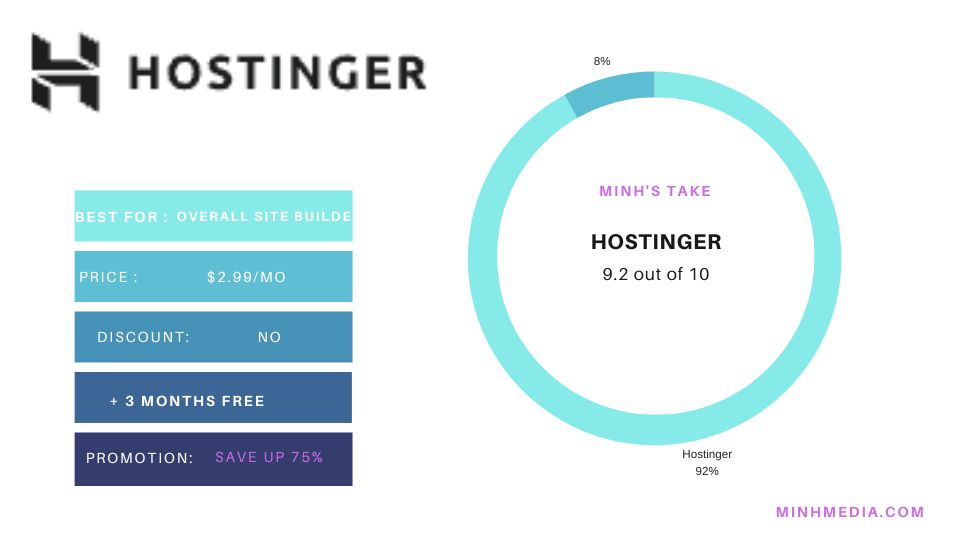
Hostinger is a web hosting platform that provides affordable hosting services and domain registration to individuals and businesses worldwide. The platform was founded in 2004 by Arnas Stuopelis and is headquartered in Kaunas, Lithuania. Hostinger has since grown to become one of the largest web hosting providers, serving over 29 million users in 178 countries.
History:
Hostinger began as a free web hosting service in 2004, offering a limited set of features to users. The company quickly gained popularity, and within a year, it had over 100,000 registered users. Hostinger then expanded its offerings to include premium hosting plans, domain registration, and website building tools. In 2007, the company launched a localized version of its platform in Brazil, marking the beginning of its global expansion.
In 2011, Hostinger launched 000webhost, a free web hosting platform that quickly gained a following. The company also expanded its presence in Europe, opening new data centers in the Netherlands, the United Kingdom, and Singapore. In 2014, Hostinger launched Zyro, a website builder that allows users to create professional-looking websites without any coding skills.
Technology:
Hostinger uses a combination of cloud-based infrastructure and a custom-built control panel to deliver fast and reliable hosting services to its users. The platform uses the latest hardware and software technologies, including solid-state drives (SSDs) and PHP 7.4 to ensure optimal performance. Hostinger also offers a range of security features, including SSL certificates, DDoS protection, and automated backups.
Achievements:
Hostinger has received numerous awards and recognitions over the years, including:
- Best Cheap Web Hosting by HostingAdvice.com
- Best Host Overall by TechRadar
- Best Web Hosting by PCMag
- Best Web Hosting by FinancesOnline
In addition to these awards, Hostinger has also been recognized for its commitment to sustainability. The company has implemented a number of initiatives to reduce its carbon footprint, including using renewable energy sources and partnering with organizations to plant trees and support reforestation efforts.
Features:
Hostinger offers a wide range of hosting plans and features to meet the needs of different users. Some of the key features of the platform include:
- Affordable pricing: Hostinger offers some of the lowest prices in the industry, making it accessible to users with different budgets.
- Easy-to-use control panel: The custom-built control panel is intuitive and user-friendly, making it easy for users to manage their hosting accounts.
- Fast loading speeds: Hostinger’s use of SSDs and cloud-based infrastructure ensures fast loading speeds for websites.
- Reliable uptime: Hostinger guarantees a 99.9% uptime, ensuring that users’ websites are always accessible.
- 24/7 customer support: Hostinger offers round-the-clock customer support via live chat and email to help users with any issues they may encounter.
Hostinger is a reliable and affordable web hosting platform that offers a range of features and services to meet the needs of different users.
User experience:
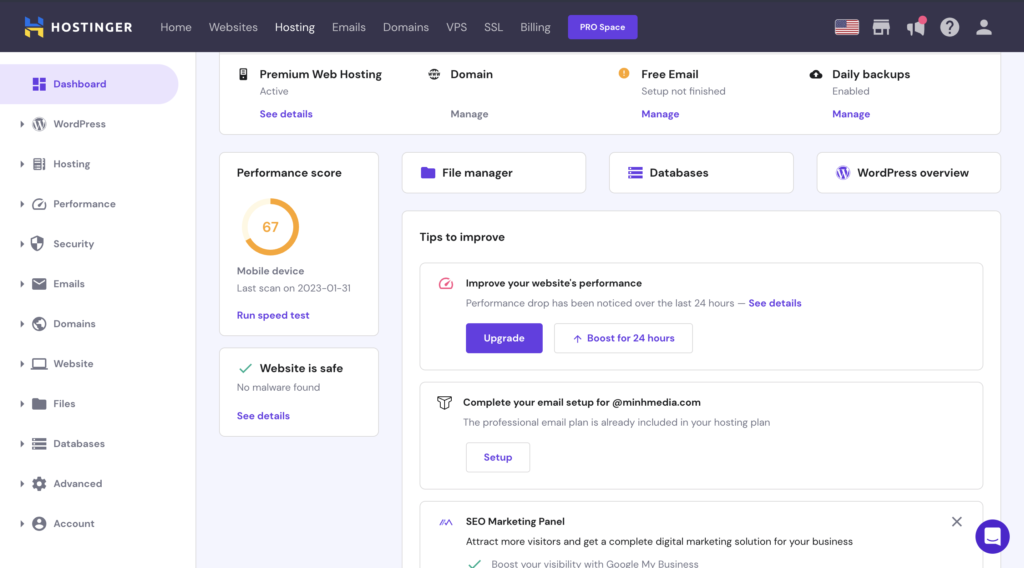
is an important aspect of any web hosting platform, and Hostinger strives to provide its users with a positive experience. The platform offers a range of tools and features to make it easy for users to manage their websites and hosting accounts.
One of the key features of Hostinger is its custom-built control panel, which is designed to be intuitive and user-friendly. The control panel allows users to manage their websites, domains, and email accounts, as well as install and manage popular applications like WordPress and Joomla. Users can also access their website’s files and databases directly from the control panel.
Hostinger also offers a range of website building tools, including Zyro, a drag-and-drop website builder that allows users to create professional-looking websites without any coding skills. The platform also supports popular content management systems like WordPress, Drupal, and Joomla, making it easy for users to build and customize their websites.
In terms of performance, Hostinger is known for its fast loading speeds and reliable uptime. The platform uses a combination of cloud-based infrastructure and SSDs to ensure optimal performance, and guarantees a 99.9% uptime. This means that users’ websites are always accessible and perform well, which can lead to a positive user experience.
Finally, Hostinger offers round-the-clock customer support via live chat and email to help users with any issues they may encounter. The support team is knowledgeable and responsive, and can help users with everything from setting up their hosting account to troubleshooting website issues.
Hostinger is designed to provide users with a positive experience. The platform offers a range of tools and features to make it easy to manage websites and hosting accounts, and provides fast performance and reliable uptime. With 24/7 customer support, users can also get help quickly and easily if they encounter any issues.
Hostinger offers ?

Hostinger offers a range of hosting plans and pricing options to meet the needs of different users. The platform is known for its affordable pricing, making it accessible to users with different budgets.
The most basic hosting plan, known as Single Shared Hosting, starts at just $0.99 per month (with a four-year commitment) and includes one website, 30 GB of storage, and 100 GB of bandwidth. This plan is suitable for users with a single website or a small number of websites with low traffic.
The Premium Shared Hosting plan starts at $2.89 per month (with a four-year commitment) and includes unlimited websites, unlimited storage, and unlimited bandwidth. This plan is suitable for users with multiple websites or websites with higher traffic.
Hostinger also offers cloud hosting, which provides higher levels of performance and scalability. The most basic cloud hosting plan starts at $9.99 per month (with a four-year commitment) and includes 2 CPU cores, 2 GB of RAM, and 100 GB of storage. The most advanced cloud hosting plan starts at $79.99 per month (with a four-year commitment) and includes 12 CPU cores, 16 GB of RAM, and 200 GB of storage.
In addition to hosting, Hostinger also offers domain registration services. Users can register a domain starting at just $0.99 for the first year (with a four-year commitment). The price for domain registration varies depending on the domain extension and availability.
Hostinger’s pricing is very competitive and affordable, making it a popular choice for users with different hosting needs and budgets.
Like any web hosting platform, Hostinger has its pros and cons. Here are some of the likes and dislikes of the platform:
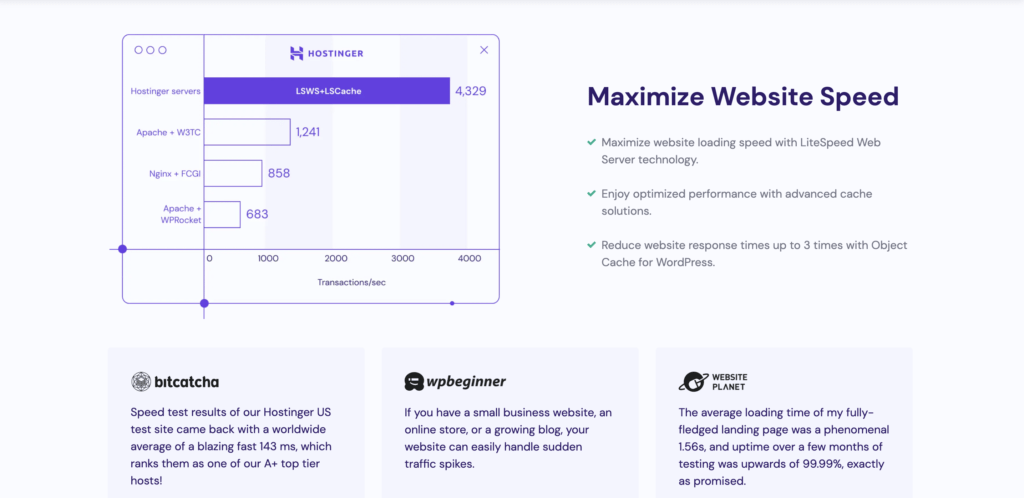
Likes:
- Affordable pricing: Hostinger offers very competitive pricing for its hosting plans, making it accessible to users with different budgets.
- User-friendly control panel: The custom-built control panel is intuitive and easy to use, even for beginners.
- Fast loading speeds: Hostinger uses a combination of cloud-based infrastructure and SSDs to ensure fast loading speeds for websites.
- Good customer support: The 24/7 customer support team is knowledgeable and responsive, and can help users with a range of issues.
- Website builder: Hostinger’s website builder, Zyro, is a great tool for users who want to create professional-looking websites without any coding skills.
Dislikes:
- There is no app available for the website builder.
- No phone support: Hostinger’s customer support is available via live chat and email, but there is no phone support available.
Hostinger is a great choice for users who want affordable and reliable hosting with good customer support. While there are some limitations to the platform, the pros generally outweigh the cons.
Hostinger regularly updates its products and services:
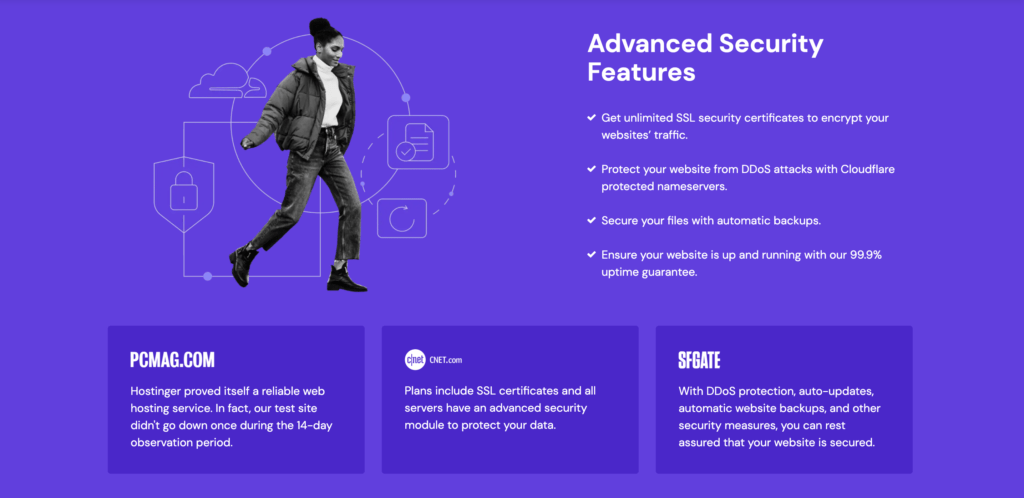
The platform have been to improve performance, security, and user experience. Here are some recent product updates from the platform
- New website builder: Hostinger recently launched a new website builder called Zyro, which is designed to be more intuitive and user-friendly than its previous website builder. Zyro includes a range of templates, blocks, and elements to help users create professional-looking websites without any coding skills.
- Cloudflare integration: Hostinger now integrates with Cloudflare, a content delivery network and security service, to provide users with faster website speeds and better security. The integration is available for all hosting plans.
- LiteSpeed web server: Hostinger has recently started using LiteSpeed, a high-performance web server, for its hosting services. This change has resulted in faster loading speeds for websites hosted on Hostinger.
- Improved security features: Hostinger has implemented a range of security measures to protect users’ websites and data. These measures include SSL certificates, firewalls, and regular backups.
- Better WordPress integration: Hostinger has improved its integration with WordPress, making it easier for users to install, manage, and customize their WordPress websites. The platform now offers a range of WordPress-specific features, including automatic updates and staging environments.
Overall, Hostinger is committed to improving its products and services to meet the needs of its users. With regular updates and improvements, the platform continues to offer reliable hosting with great features and performance.
#2 Wix: Build and scale with confidence. From a powerful website builder to advanced business solutions—we’ve got you covered.

Wix.com is a cloud-based web development platform that allows users to create and manage websites without any coding skills. Here is a detailed introduction to the platform, including its history, technology, achievements, and features:
History:
Wix.com was founded in 2006 by Avishai Abrahami, Nadav Abrahami, and Giora Kaplan. The platform was launched in 2008 and quickly gained popularity among users who wanted an easy and affordable way to create websites. Today, Wix.com has over 200 million registered users and is one of the leading website builders in the world.
Technology:
Wix.com is built on a proprietary platform that uses a drag-and-drop interface to allow users to create websites without any coding. The platform uses a combination of HTML5, CSS3, and JavaScript to create responsive and interactive websites. Wix also uses a cloud-based infrastructure to ensure fast loading speeds and high availability for websites hosted on the platform.
Achievements:
Wix.com has won numerous awards for its platform and services. In 2021, Wix was named the “Best Website Builder” by TechRadar, and was awarded a Webby Award for “Best Visual Design – Function” in 2020. The platform has also been recognized for its user-friendly interface and innovative features, such as the Wix Artificial Design Intelligence (ADI) tool.

Key Features:
Wix.com offers a range of features to help users create and manage their websites. Here are some of the key features of the platform:
- Drag-and-drop website builder: Wix’s website builder allows users to create custom websites without any coding skills. The drag-and-drop interface makes it easy to add and arrange elements on the page, and there are a range of templates and designs to choose from.
- Wix ADI: Wix’s Artificial Design Intelligence tool can create a custom website for users based on their preferences and needs. The tool uses machine learning algorithms to create a unique design and layout for each website.
- App Market: Wix has an App Market that allows users to add additional functionality to their websites. The market includes a range of apps and widgets, such as forms, social media integrations, and e-commerce tools.
- E-commerce: Wix offers a range of e-commerce features to help users sell products and services online. This includes a built-in shopping cart, payment processing, and inventory management tools.
- SEO: Wix offers a range of SEO tools to help users optimize their websites for search engines. This includes customizable meta tags, site maps, and analytics tools.
Wix.com is a powerful and user-friendly website builder:
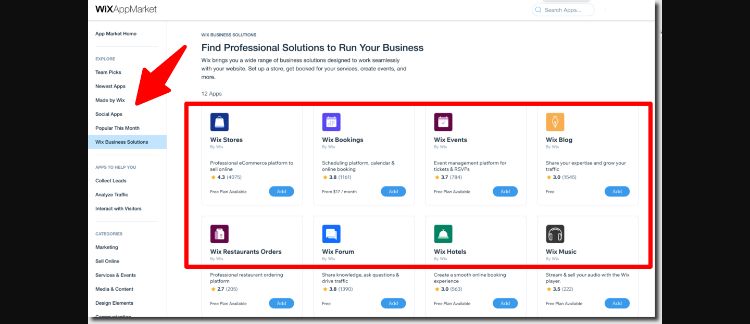
that offers a range of features to help users create and manage their websites. With its innovative technology and easy-to-use interface, Wix is a popular choice for users with different website needs and skill levels.
Wix.com is known for its user-friendly interface and easy-to-use tools, making it a popular choice among users who want to create and manage their own websites. Here are some aspects of the user experience on Wix:
- Ease of use: Wix’s drag-and-drop website builder makes it easy for users to create custom websites without any coding skills. The platform offers a range of templates and designs to choose from, and users can easily add and arrange elements on the page.
- Design flexibility: Wix’s website builder offers a high degree of design flexibility, allowing users to customize their websites to their exact specifications. Users can choose from a range of fonts, colors, and layouts, and can add their own images and videos to create a unique look and feel.
- App Market: Wix’s App Market offers a range of additional features and functionality that users can add to their websites. This includes e-commerce tools, social media integrations, and form builders, among others. The App Market makes it easy for users to extend the functionality of their websites without having to code anything themselves.
- Mobile responsiveness: Wix’s websites are designed to be responsive, meaning they adapt to different screen sizes and devices. This ensures that websites look great and are easy to navigate on both desktop and mobile devices.
- Customer support: Wix offers a range of customer support options, including email support, a knowledge base, and a community forum. The platform also offers phone support for users on higher-tier plans.
Overall, the user experience on Wix.com is positive, with many users praising the platform for its ease of use, design flexibility, and range of features. With its user-friendly interface and powerful tools, Wix is a popular choice for users who want to create and manage their own websites without any coding skills.

Here are some of the likes and dislikes of Wix.com based on user feedback:
Likes:
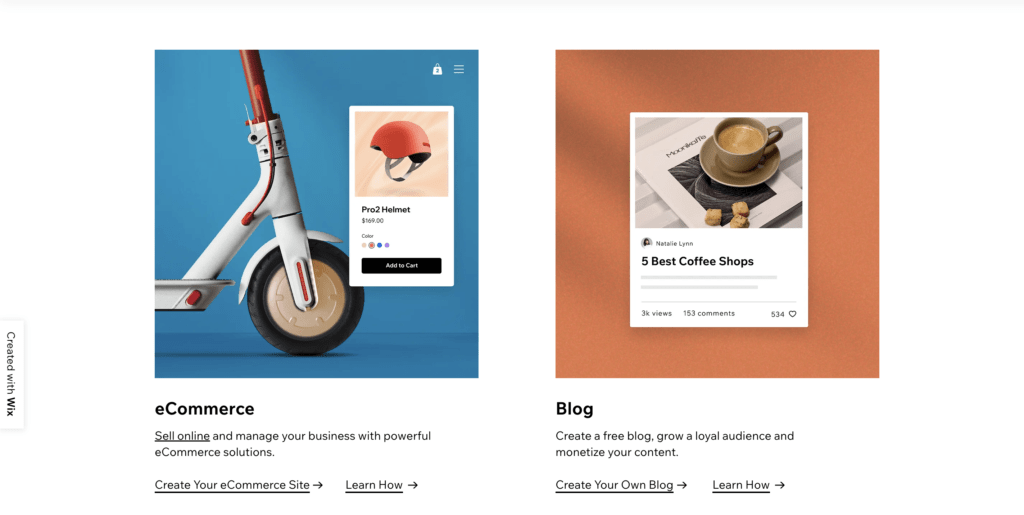

- Easy to use: Many users appreciate how easy it is to create a website on Wix, even without any coding skills. The drag-and-drop interface and user-friendly tools make it easy to create a custom website quickly.
- Design flexibility: Wix offers a high degree of design flexibility, allowing users to customize their websites to their exact specifications. Users can choose from a range of templates and designs, and can add their own images, videos, and other elements to create a unique look and feel.
- Range of features: Wix offers a wide range of features and tools, including e-commerce functionality, social media integration, and a range of third-party apps and widgets. This allows users to create a website that meets their specific needs and goals.
- Mobile responsiveness: Wix’s websites are designed to be responsive, meaning they adapt to different screen sizes and devices. This ensures that websites look great and are easy to navigate on both desktop and mobile devices.
Dislikes:
- Limited design control: While Wix offers a lot of design flexibility, some users have complained that there are certain limitations to what they can customize. For example, some templates may not allow for certain design changes or layout modifications.
- Loading speed: Some users have reported slow loading speeds on Wix websites, particularly on mobile devices. While Wix’s cloud-based infrastructure is designed to be fast and reliable, website loading times may vary depending on factors such as website complexity and user location.
- Price: Wix’s pricing plans can be expensive for users who want to access certain features or tools. While there is a free plan available, users may need to upgrade to a higher-tier plan to access advanced features like e-commerce or more storage space.
While Wix has many positives such as its ease of use, design flexibility and range of features, there are also some limitations such as design control and pricing that some users may find frustrating.
Wix offers a range of pricing plans to suit different needs and budgets. Here is an overview of the pricing plans available:
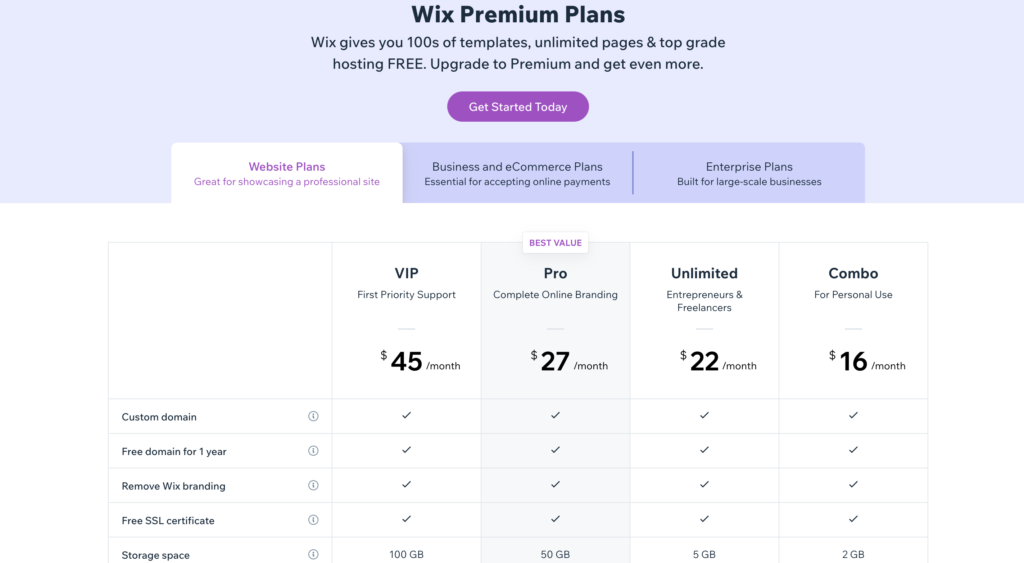
- Free: Wix offers a free plan, which allows users to create a website with limited features and functionality. This plan includes Wix branding on the website and limited storage space.
- Combo: The Combo plan is the most basic paid plan and starts at $16 per month (when billed annually). This plan includes a custom domain name, more storage space, and access to a range of additional features and tools.
- Unlimited: The Unlimited plan starts at $22 per month (when billed annually) and includes everything in the Combo plan, plus unlimited bandwidth and more storage space.
- Pro: The Pro plan starts at $27 per month (when billed annually) and includes everything in the Unlimited plan, plus access to more advanced features and tools, such as professional logo design and advanced analytics.
- VIP: The VIP plan is the most expensive plan and starts at $45 per month (when billed annually). This plan includes everything in the Pro plan, plus priority support, a VIP support line, and more.
Wix also offers a range of e-commerce pricing plans for users who want to sell products or services online. These plans start basic plan at $27 per month (when billed annually) and include additional features such as e-commerce functionality, payment processing, and shipping integration.
Overall, while some of Wix’s pricing plans can be expensive, the platform offers a range of features and tools that can be customized to meet specific needs and budgets.
#3 Web.com: Our pros will design & build a website with everything you need to shine online
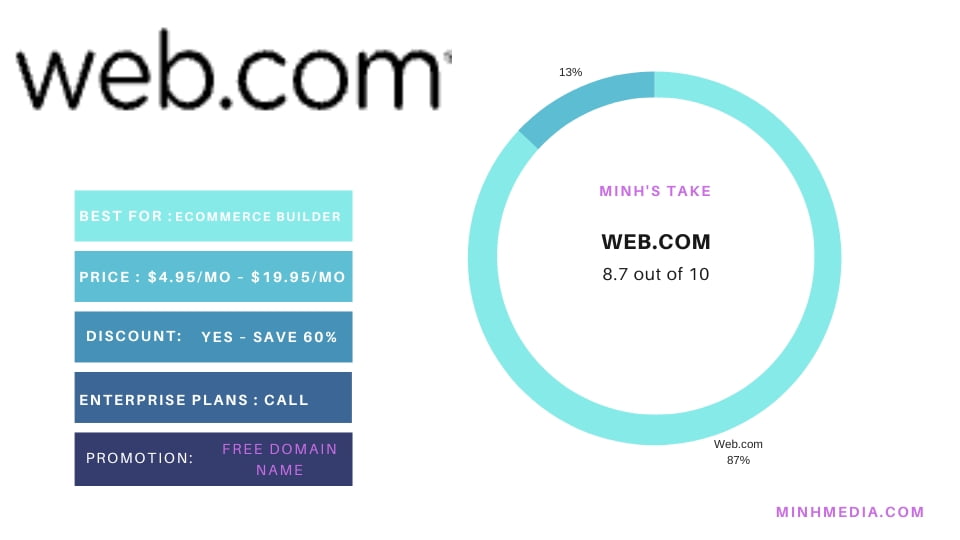
Web.com is a web hosting and website builder platform that provides businesses and individuals with tools to create and manage their online presence. Here is a detailed introduction to the platform, including its history, technology, achievements, and features.
History:
Web.com was founded in 1997 as Website Pros, Inc. and later changed its name to Web.com Group, Inc. The company is headquartered in Jacksonville, Florida, and has offices in several other countries. Web.com has a long history of providing website design, hosting, and marketing services to small businesses and individuals.
Technology:
Web.com offers a range of tools and technologies to help users create and manage their websites. The platform provides a drag-and-drop website builder, as well as a range of customizable templates and themes. Users can also access a range of e-commerce tools, such as shopping cart functionality and payment processing.
Web.com uses a cloud-based infrastructure to ensure that websites are fast, reliable, and secure. The platform also provides a range of security features, such as SSL certificates and malware scanning, to protect user data and ensure that websites are safe for visitors.
Achievements:
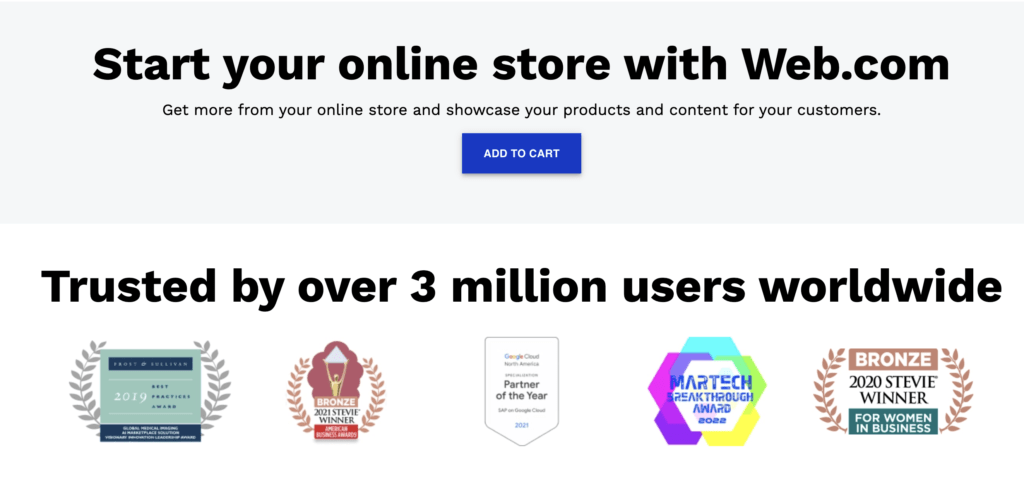
Web.com has received several awards and accolades for its services. In 2019, the company was named a finalist in the Stevie Awards for Sales & Customer Service, and in 2020, it was recognized as a Top Performer by FeaturedCustomers, a leading customer reference platform. Web.com has also been recognized for its commitment to sustainability and environmental responsibility.
Key Features:
Web.com offers a range of features and tools to help users create and manage their websites. Here are some of the key features:
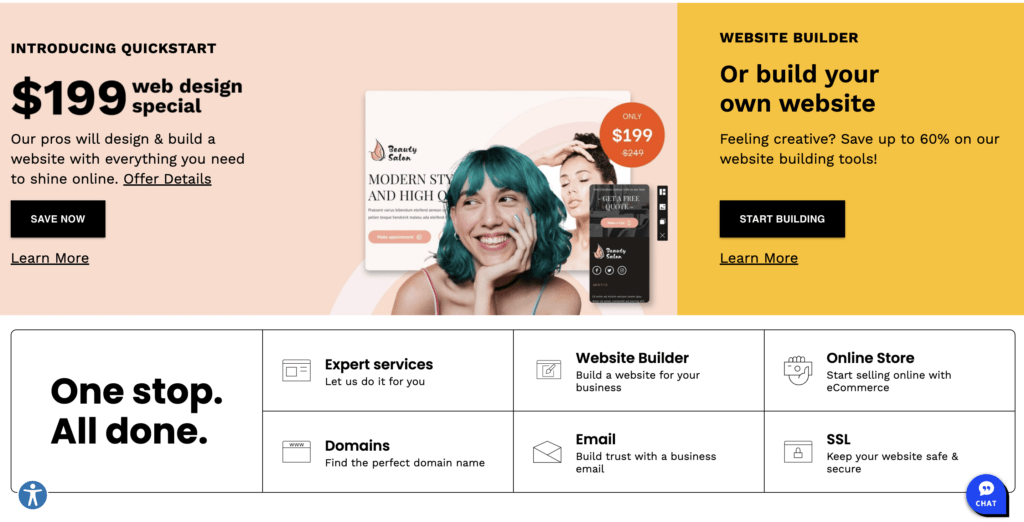
- Website builder: Web.com’s website builder provides a drag-and-drop interface and customizable templates and themes to help users create professional-looking websites quickly and easily.
- E-commerce functionality: Web.com offers a range of e-commerce tools, such as shopping cart functionality and payment processing, to help businesses sell products and services online.
- Domain registration: Web.com offers domain registration services, allowing users to register a custom domain name for their website.
- Marketing tools: Web.com provides a range of marketing tools, such as search engine optimization (SEO) and social media integration, to help businesses promote their websites and reach more customers.
- Security features: Web.com offers a range of security features, such as SSL certificates and malware scanning, to protect user data and ensure that websites are safe for visitors.
Web.com provides a comprehensive set of tools and features to help users create and manage their online presence. The platform’s focus on ease of use, e-commerce functionality, and security make it a popular choice for small businesses and individuals looking to build a website.
Web.com has received mixed reviews when it comes to user experience. While some users have found the platform easy to use and helpful for building their websites, others have experienced issues with customer support and technical difficulties.
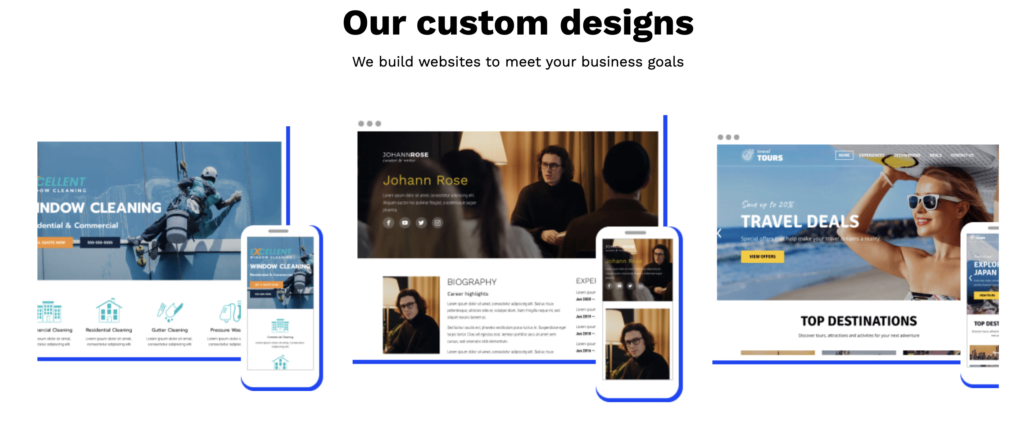
One common complaint from users is that customer support can be difficult to reach or unhelpful when issues arise. Some users have reported long wait times on the phone and unresponsive email support.
In terms of the website builder, some users have found it easy to use and appreciate the drag-and-drop interface and customizable templates. However, others have reported issues with the platform’s usability and customization options.
Another area where Web.com has received mixed reviews is in its e-commerce functionality. While some users have found the platform helpful for selling products and services online, others have reported issues with payment processing and order fulfillment.
Overall, user experience with Web.com seems to be mixed. While the platform offers a range of features and tools to help users create and manage their online presence, some users have reported issues with customer support and technical difficulties.
Like any web hosting and website building platform, Web.com has its strengths and weaknesses. Here are some common likes and dislikes users have reported about the platform:
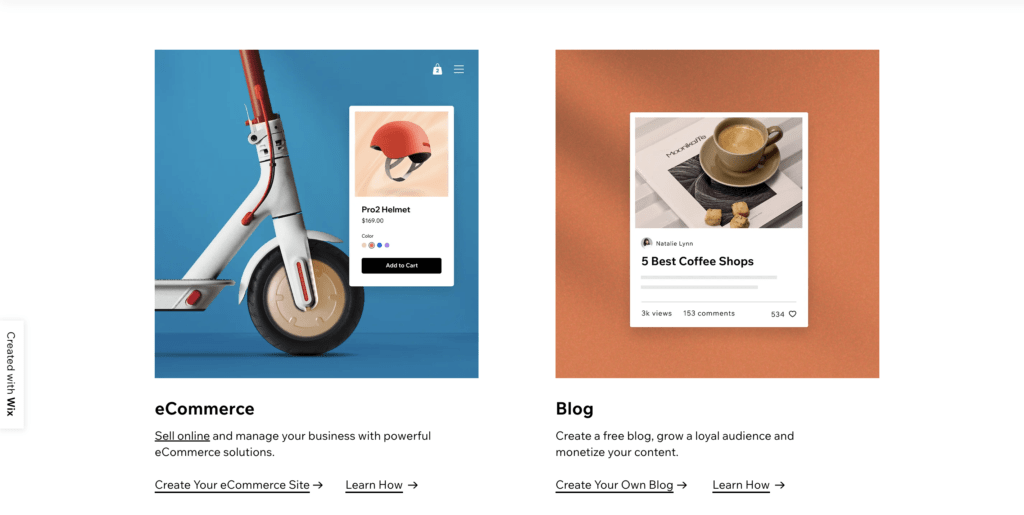

Likes:
- Easy to use website builder: Many users have reported finding the website builder easy to use and appreciate the drag-and-drop interface and customizable templates.
- E-commerce functionality: Web.com offers a range of e-commerce tools, such as shopping cart functionality and payment processing, which many users appreciate for selling products and services online.
- Domain registration: Web.com offers domain registration services, which many users appreciate for registering custom domain names for their website.
- Marketing tools: Web.com provides a range of marketing tools, such as SEO and social media integration, to help businesses promote their websites and reach more customers.
- Security features: Web.com offers a range of security features, such as SSL certificates and malware scanning, to protect user data and ensure that websites are safe for visitors.
Dislikes:
- Customer support: Some users have reported issues with customer support being difficult to reach or unhelpful when issues arise.
- Technical difficulties: Some users have reported experiencing technical difficulties with the platform, such as slow loading times and glitches.
- Limited customization: Some users have reported feeling limited in their ability to customize their website beyond the available templates and themes.
- Pricing: Some users have reported finding Web.com’s pricing to be higher than competitors.
Overall, while Web.com has its strengths in features like e-commerce functionality, marketing tools, and security features, it also has its weaknesses in areas like customer support and technical difficulties. However, user experience can vary depending on individual needs and preferences, so it is important to consider all factors when evaluating a web hosting and website building platform.
Web.com offers a range of pricing plans for web hosting and website building services. Here are the main pricing plans:
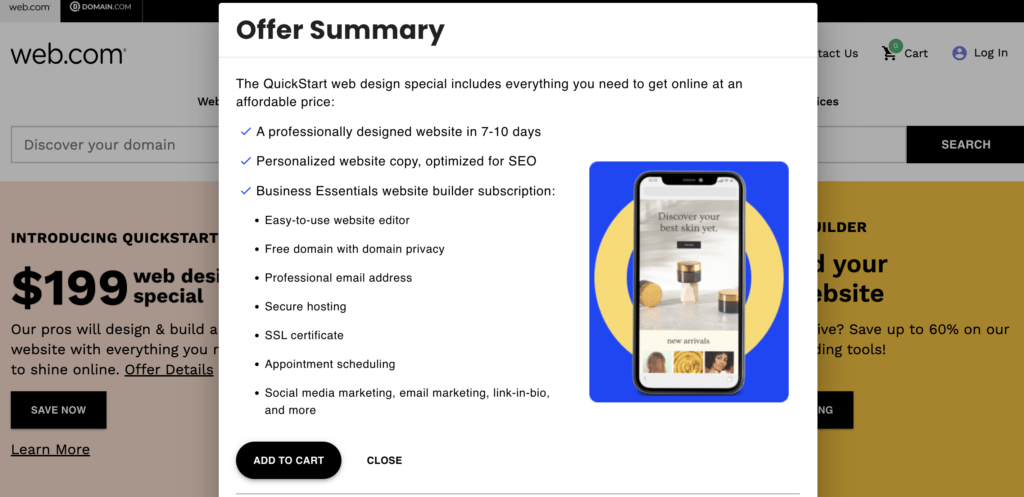
- Website Builder: Web.com’s website builder pricing plans range from $1.95 to $29.95 per month, depending on the features and functionality included. The plans come with various levels of design customization, e-commerce functionality, and marketing tools.
- Web Hosting: Web.com’s web hosting pricing plans range from $5.95 to $11.95 per month, depending on the level of hosting features and functionality. The plans include different levels of storage and bandwidth, email accounts, and security features.
- Online Marketing: Web.com’s online marketing pricing plans range from $39.95 to $79.95 per month, depending on the level of marketing features and functionality. The plans include various levels of SEO optimization, social media integration, and advertising management.
- Domain Registration: Web.com also offers domain registration services, with pricing ranging from $15 to $50 per year, depending on the domain extension.

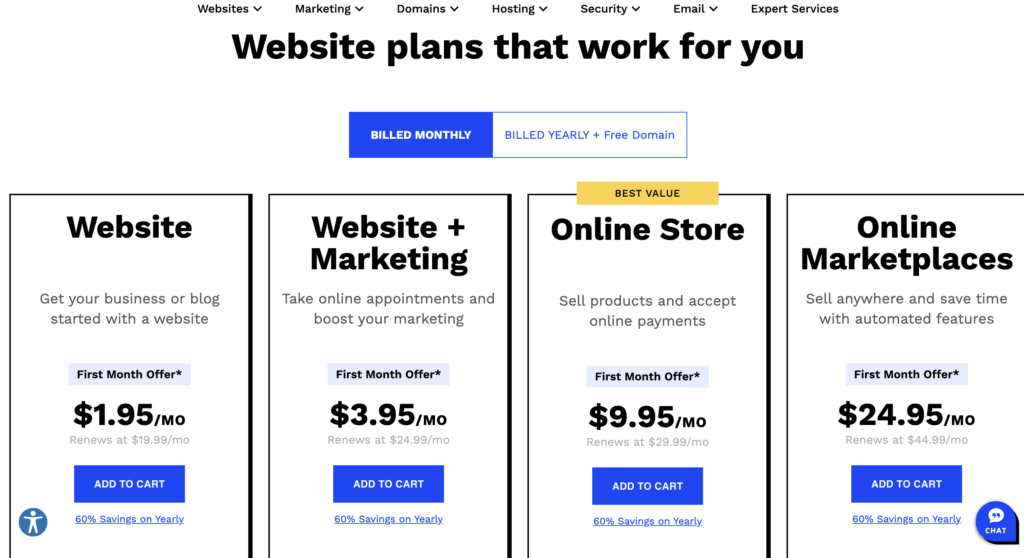
It is worth noting that pricing and plans may vary depending on promotional offers and discounts. Additionally, some features, such as e-commerce functionality, may require additional fees or plans beyond the basic pricing. Overall, Web.com’s pricing is competitive with other web hosting and website building platforms on the market.
Product Updates ?
Web.com regularly releases updates and new features to its web hosting and website building platform. Here are some recent product updates:
- New website templates: Web.com has added new website templates to its website builder, giving users more options for designing and customizing their websites.
- Enhanced e-commerce functionality: Web.com has added new features to its e-commerce functionality, such as order tracking and inventory management, to help businesses streamline their online sales.
- Improved website speed: Web.com has made improvements to website speed and performance, reducing loading times and improving user experience for visitors.
- Enhanced security features: Web.com has added new security features, such as DDoS protection and site backup, to protect user data and ensure website safety.
- Improved customer support: Web.com has made improvements to its customer support, offering faster response times and more helpful resources for users.
- Updated online marketing tools: Web.com has updated its online marketing tools, such as SEO optimization and social media integration, to help businesses reach more customers and improve their online presence.
These product updates demonstrate Web.com’s commitment to improving its platform and providing users with new and enhanced features to help them create and manage their online presence.
#4 Godaddy Turn your small business into a big brand

GoDaddy is a well-known platform that provides a range of services for individuals and businesses, including domain registration, web hosting, website building, and online marketing tools. Here is a detailed introduction to the GoDaddy platform:
History: GoDaddy was founded in 1997 by Bob Parsons as Jomax Technologies, and it later changed its name to GoDaddy in 1999. The company is headquartered in Scottsdale, Arizona, and has grown to become one of the largest domain registrars and web hosting providers in the world. Over the years, GoDaddy has expanded its services and acquired several other companies to offer a comprehensive suite of products for online presence management.
Technology: GoDaddy utilizes advanced technology to power its services. The company has a robust infrastructure of data centers spread across various locations worldwide, ensuring reliable and secure hosting for websites. GoDaddy’s technology stack includes scalable servers, efficient network infrastructure, and security measures to protect customer data and website assets.
Achievements: GoDaddy has achieved significant milestones and garnered recognition in the industry. Some notable achievements include:
- Domain Registrar: GoDaddy is one of the largest domain registrars globally, managing millions of domain names for individuals and businesses.
- Web Hosting Provider: GoDaddy offers a range of hosting services, including shared hosting, VPS hosting, and dedicated servers, serving millions of websites worldwide.
- Website Builder: GoDaddy’s website builder tools have empowered countless individuals and businesses to create professional websites without the need for technical expertise.
- Customer Base: GoDaddy has built a vast customer base, catering to the needs of entrepreneurs, small businesses, and established enterprises alike.
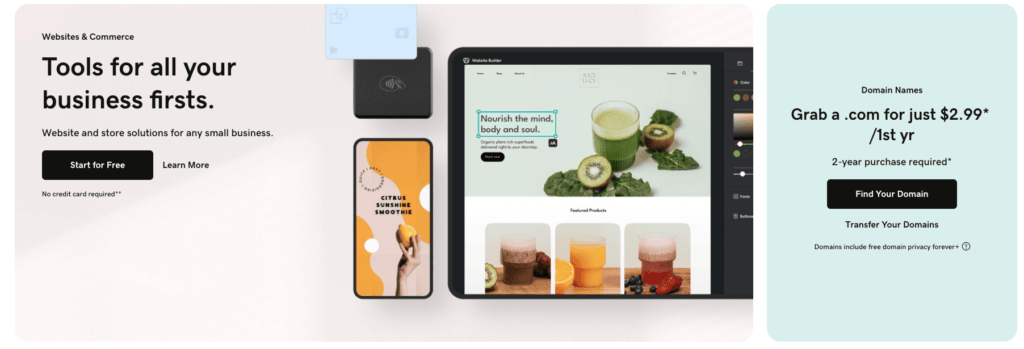
Features: GoDaddy offers a wide range of features to help individuals and businesses establish and manage their online presence. Some key features of the GoDaddy platform include:
- Domain Registration: GoDaddy allows users to search for and register domain names of their choice, along with domain management tools.
- Web Hosting: GoDaddy provides various hosting plans, offering features such as ample storage, bandwidth, email accounts, and website backup.
- Website Builder: GoDaddy offers a user-friendly website builder with customizable templates, drag-and-drop functionality, and e-commerce integration.
- Online Marketing Tools: GoDaddy offers tools for search engine optimization (SEO), email marketing, social media integration, and online advertising to help businesses promote their websites effectively.
- Security: GoDaddy offers SSL certificates, website security features, and malware scanning to ensure the protection of websites and customer data.
- Customer Support: GoDaddy provides 24/7 customer support via phone, live chat, and email to assist customers with any technical or account-related issues.
GoDaddy’s comprehensive set of services, user-friendly interface, and commitment to customer support have made it a popular choice for individuals and businesses looking to establish and manage their online presence effectively.
Here are some common likes and dislikes reported by users regarding the GoDaddy platform:
Likes:
- User-Friendly Interface: Users appreciate GoDaddy’s intuitive interface, which makes it easy to navigate and manage various services, including domain registration, hosting, and website management.
- Domain Availability and Pricing: GoDaddy offers a wide selection of domain names and competitive pricing, making it convenient for users to find and register their desired domain names.
- Website Builder: Many users find GoDaddy’s website builder tools helpful, especially for those without coding or design skills. The drag-and-drop functionality and customizable templates allow users to create professional-looking websites quickly.
- Customer Support: GoDaddy is known for its responsive and helpful customer support, providing assistance with technical issues, domain management, and hosting queries.
Dislikes:
- Upselling and Additional Costs: Some users feel that GoDaddy’s checkout process involves upselling and additional costs for services or features that they may not need, leading to a higher overall cost.
- Website Performance: While GoDaddy offers reliable hosting services, some users have reported occasional issues with website loading speed or performance, especially during peak traffic periods.
- Complexity for Advanced Users: Advanced users who require more advanced customization options or access to server configurations may find GoDaddy’s platform somewhat limited compared to more specialized hosting providers.
- Renewal Pricing: Some users have expressed concerns about the renewal pricing for domain names and hosting services, as they can increase significantly after the initial promotional period.
It’s important to note that experiences and opinions can vary among users, and what may be a dislike for one user might not be an issue for another. Overall, GoDaddy is favored by many users for its user-friendly interface, domain availability, website builder tools, and reliable customer support.
GoDaddy offers a range of services with different pricing options. Here is an overview of the pricing for some of their popular services:
- Domain Registration: The pricing for domain registration varies depending on the top-level domain (TLD) and availability of the desired domain name. The cost can range from a few dollars to higher amounts for premium domains.
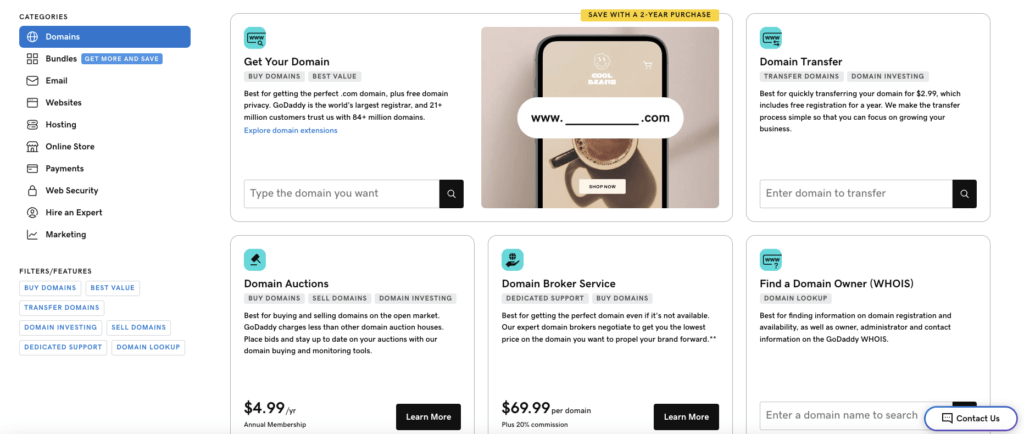
2- Web Hosting: GoDaddy provides several hosting plans, including shared hosting, VPS hosting, and dedicated servers.
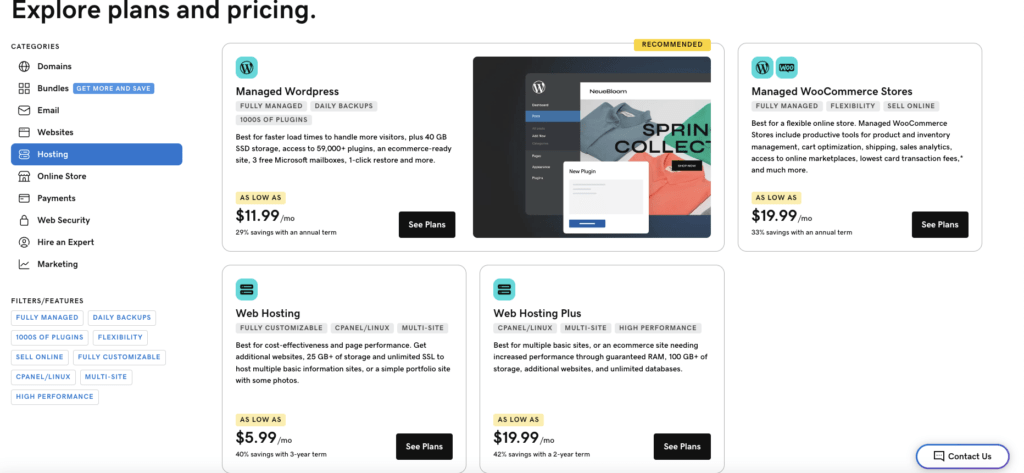
3-Website Builder: GoDaddy’s website builder is available through different plans.
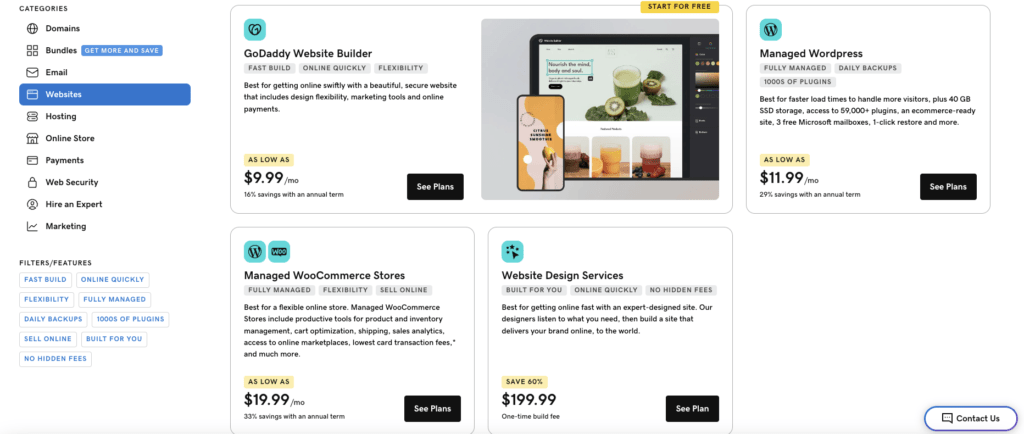
4-Email Hosting: GoDaddy offers email hosting services, with pricing that starts at:
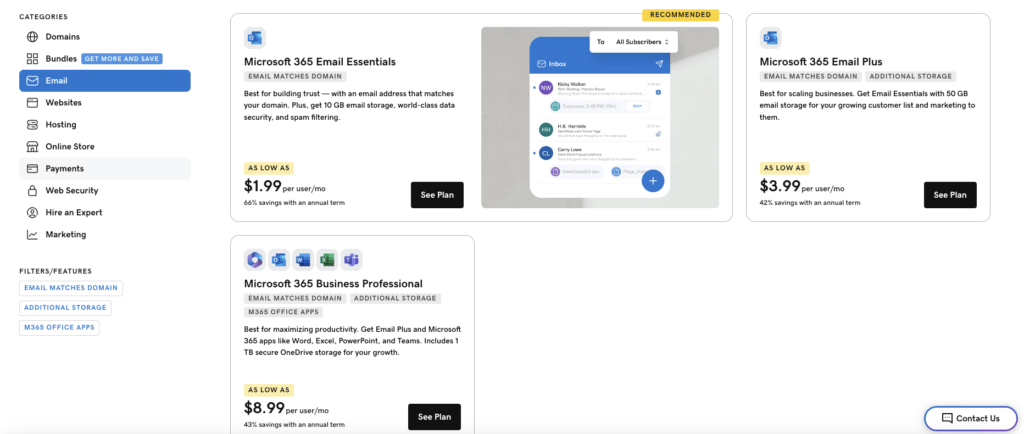
5- Online Marketing Tools: GoDaddy provides online marketing tools, including SEO, email marketing, and social media promotion. The pricing for these tools can vary depending on the specific service and features required.
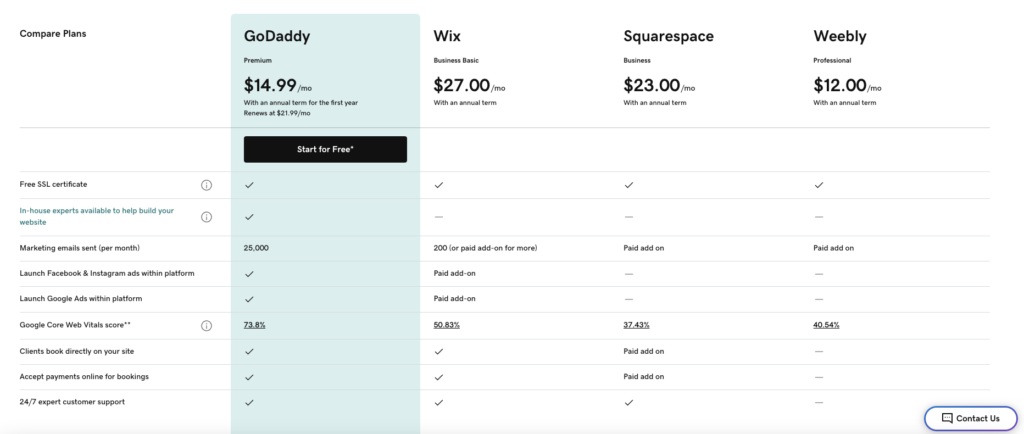
It’s important to note that GoDaddy often offers promotional discounts and special offers for new customers, so the actual pricing may vary based on the current promotions. Additionally, pricing for some services may change based on the specific requirements and add-ons chosen by the user.
For the most accurate and up-to-date pricing information, it is recommended to visit GoDaddy’s official website or contact their sales team.
Product Updates?
GoDaddy regularly updates its services and features to enhance user experience and meet evolving industry standards. Some common areas of product updates include:
- Improved Website Builder: GoDaddy often introduces new templates, design options, and customization features to their website builder, allowing users to create more visually appealing and functional websites.
- Hosting Performance Enhancements: GoDaddy focuses on optimizing hosting infrastructure to improve website loading speed, reliability, and security. These updates may include server upgrades, caching mechanisms, and security enhancements.
- E-commerce Functionality: GoDaddy has introduced updates to its e-commerce solutions, such as online store builders, shopping cart features, payment gateway integrations, and inventory management tools.
- Security Enhancements: GoDaddy continually works on improving security measures to protect websites and customer data. This includes implementing SSL certificates, malware scanning, firewall protections, and regular security patches.
- User Interface and Dashboard Enhancements: GoDaddy may update the user interface and dashboard of its platform to improve usability, navigation, and overall user experience.
- Integration with Third-Party Tools: GoDaddy often expands its integrations with popular tools and platforms, such as content management systems, email marketing software, and social media platforms, allowing users to connect and streamline their workflows.
Please note that the specific product updates and enhancements can vary over time, and it is recommended to visit the official GoDaddy website or contact their customer support for the most accurate and up-to-date information on product updates.
User experience ?

The user experience on GoDaddy can vary based on individual preferences and needs. Here is an overview of the user experience aspects commonly associated with GoDaddy:
- User-Friendly Interface: GoDaddy is known for its user-friendly interface that makes it relatively easy for users to navigate and manage their domains, hosting, and other services. The platform offers intuitive menus, clear instructions, and a straightforward layout.
- Domain Management: GoDaddy provides a user-friendly domain management interface where users can register, renew, transfer, and update their domain names. The process is generally straightforward and allows users to manage their domains efficiently.
- Website Building: GoDaddy offers a website builder tool that caters to users with different levels of technical expertise. The drag-and-drop functionality, customizable templates, and pre-built sections make it relatively easy for users to create and update their websites without coding knowledge.
- Hosting Management: GoDaddy’s hosting management interface allows users to manage their hosting plans, set up email accounts, access file management tools, and configure settings. The interface is designed to be user-friendly and provides easy access to common hosting features.
- Customer Support: GoDaddy offers customer support through various channels, including phone, live chat, and email. Users generally appreciate the responsive and knowledgeable support team that can assist with technical issues, billing inquiries, and other concerns.
- Upselling and Additional Offers: Some users have reported that GoDaddy’s checkout process involves upselling additional products or services, which can be seen as both positive or negative depending on individual preferences. While some users appreciate the availability of supplementary tools and services, others may find the additional offers distracting or unnecessary.
- Performance and Reliability: GoDaddy aims to provide reliable performance for websites hosted on their platform. However, some users have reported occasional issues with website loading speed or server performance, particularly during peak traffic periods.
It’s important to note that user experiences can vary based on individual needs, technical knowledge, and expectations. While GoDaddy strives to offer a user-friendly experience, some users may have different preferences or requirements that could impact their overall satisfaction with the platform. It’s advisable to explore and evaluate the platform based on your specific needs and consider reading user reviews to gather insights from a broader user base.
#5 Squarespace :Get inspired by a collection of websites made by Squarespace users.
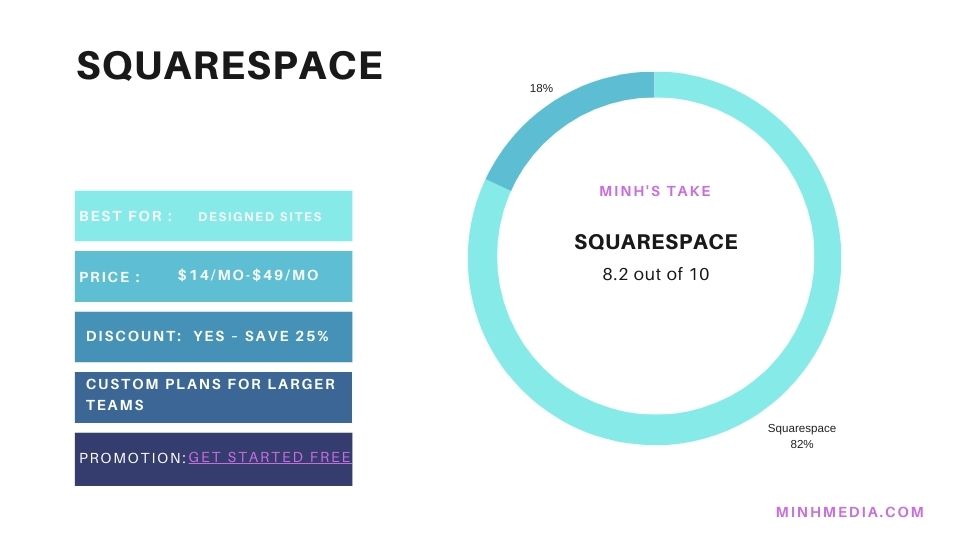
Squarespace is a popular website building and hosting platform that enables individuals and businesses to create professional and visually appealing websites. Here is a detailed introduction to the Squarespace platform:
History: Squarespace was founded in 2003 by Anthony Casalena. It started as a dorm room project at the University of Maryland and has since grown into a leading website building and hosting platform. Over the years, Squarespace has gained recognition for its sleek templates, user-friendly interface, and comprehensive features.
Technology: Squarespace utilizes advanced technology to power its platform. It leverages a combination of cloud infrastructure, content delivery networks (CDNs), and optimized servers to ensure fast and reliable website performance. Squarespace also incorporates responsive design principles, allowing websites to automatically adjust to different screen sizes and devices.
Achievements: Squarespace has achieved several milestones and received recognition for its platform and services. Some notable achievements include:
- Design Excellence: Squarespace has earned praise for its visually stunning and professionally designed templates. The platform’s focus on aesthetics and design has attracted a wide range of users, including photographers, artists, and creative professionals.
- User-Friendly Interface: Squarespace is known for its user-friendly interface that simplifies the website building process. The drag-and-drop editor, intuitive navigation, and pre-built content blocks make it accessible for users with varying technical skills.
- E-commerce Capabilities: Squarespace offers robust e-commerce features, allowing users to create online stores and sell products. It provides integrated payment gateways, inventory management, order processing, and customizable product options.
- Mobile Optimization: Squarespace ensures that websites built on its platform are optimized for mobile devices. This includes responsive design, mobile-friendly templates, and touch-friendly navigation, enabling users to reach their audience across different devices.
- Customer Support: Squarespace offers customer support through various channels, including email, live chat, and a knowledge base. The platform provides resources, tutorials, and guides to assist users in creating and managing their websites.
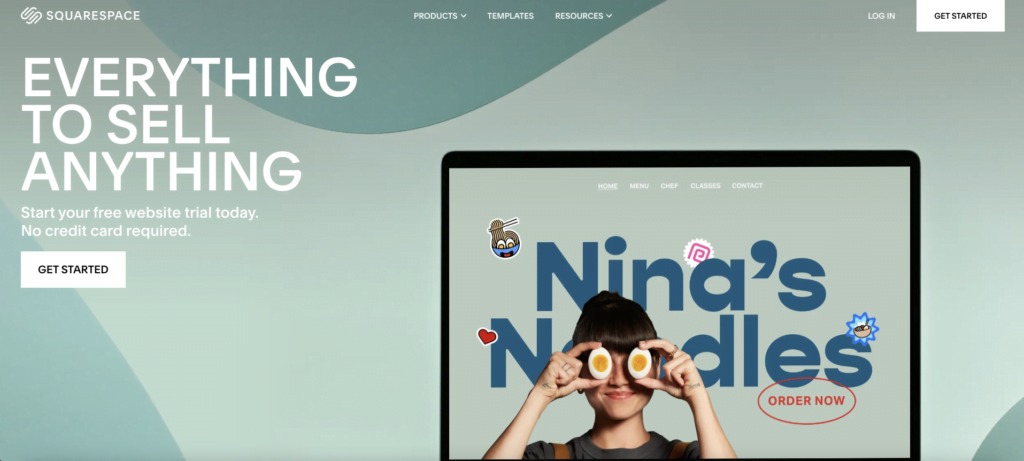
Features: Squarespace offers a range of features to empower users in building and managing their websites. Some key features of the Squarespace platform include:
- Templates: Squarespace provides a collection of professionally designed templates that can be customized to create unique websites. The templates cover various industries and styles, catering to different aesthetic preferences.
- Website Building: The platform offers a drag-and-drop website builder that allows users to easily add and arrange content elements, including text, images, videos, and forms. Users can also customize the design, typography, and color schemes to match their branding.
- Blogging and Content Management: Squarespace includes blogging functionality with features such as categories, tags, scheduled publishing, and social sharing. It also provides a robust content management system for organizing and editing website content.
- E-commerce: Squarespace offers comprehensive e-commerce capabilities, enabling users to set up online stores, manage products, process orders, and accept payments through integrated payment gateways.
- SEO Tools: Squarespace provides built-in SEO features, such as customizable page titles, meta descriptions, and clean URL structures. These tools help optimize websites for search engine visibility.
- Analytics: Squarespace offers website analytics that provide insights into site traffic, visitor behavior, and popular content. Users can monitor performance, track conversions, and make data-driven decisions.
Squarespace’s combination of visually appealing templates, user-friendly interface, e-commerce capabilities, and customer support has made it a popular choice for individuals and businesses seeking to create professional websites.
Here are some common likes and dislikes reported by users regarding the Squarespace platform:
Likes:
- Beautiful Design Templates: Users appreciate Squarespace for its stunning and professionally designed templates. The platform offers a wide range of visually appealing options that allow users to create aesthetically pleasing websites.
- User-Friendly Interface: Squarespace is known for its intuitive and user-friendly interface. The drag-and-drop editor, easy-to-navigate dashboard, and straightforward settings make it accessible for users with varying technical skills.
- Mobile Responsiveness: Squarespace ensures that websites built on its platform are mobile-responsive. This means that websites automatically adapt to different screen sizes and devices, providing a consistent user experience across desktop, tablet, and mobile.
- E-commerce Functionality: Users appreciate Squarespace’s e-commerce capabilities, which include integrated payment gateways, inventory management, and customizable product options. It allows businesses to create online stores and sell products effectively.
- Design Customization: Squarespace offers extensive design customization options, allowing users to personalize their websites to match their branding and vision. Users can customize layouts, fonts, colors, and other design elements to create a unique online presence.
Dislikes:
- Learning Curve for Advanced Customization: Some users find it challenging to customize Squarespace websites beyond the capabilities provided by the platform’s templates and design settings. Advanced customization often requires knowledge of coding or CSS, limiting flexibility for users with specific design requirements.
- Limited Third-Party Integrations: While Squarespace offers some integrations with popular services, some users have expressed a desire for more extensive integration options. The platform may have limitations when it comes to integrating with certain third-party tools or services.
- Pricing: Squarespace’s pricing structure is considered by some users to be on the higher side compared to other website building platforms. The cost can be a factor, especially for individuals or small businesses on a tight budget.
- Lack of Full Code Access: Squarespace operates on a closed platform, which means users don’t have full access to the underlying code. This restriction may limit the ability to implement certain advanced functionalities or make extensive customizations.
- Limited Blogging Features: While Squarespace provides basic blogging functionality, some users have expressed a desire for more advanced blogging features, such as native comment systems or advanced categorization options.
It’s important to note that experiences and opinions can vary among users, and what may be a dislike for one user might not be an issue for another. Overall, Squarespace is favored by many users for its beautiful design templates, user-friendly interface, mobile responsiveness, and e-commerce capabilities.
Squarespace offers different pricing plans to accommodate various user needs. Here are the pricing details for Squarespace services:

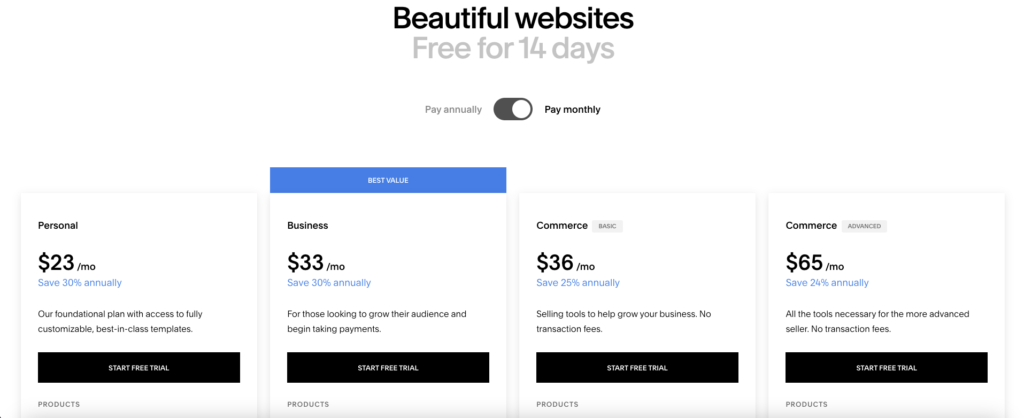
- Personal Plan: The Personal plan is priced at $16 per month when billed annually. It includes features such as a free custom domain for the first year, unlimited bandwidth and storage, SSL security, and 24/7 customer support.
- Business Plan: The Business plan is priced at $23 per month when billed annually. In addition to the features of the Personal plan, it offers advanced features like promotional pop-ups, professional email from Google, and access to premium integrations and blocks.
- Basic Commerce Plan: The Basic Commerce plan is priced at $27 per month when billed annually. It includes all the features of the Business plan and adds e-commerce capabilities, such as the ability to sell unlimited products, accept online payments, and manage inventory.
- Advanced Commerce Plan: The Advanced Commerce plan is priced at $49 per month when billed annually. It offers all the features of the Basic Commerce plan, along with advanced e-commerce features like abandoned cart recovery, gift cards, and the ability to offer subscriptions.
Please note that these prices are subject to change, and Squarespace may offer promotions or discounts from time to time. It’s always a good idea to visit the Squarespace website to get the most up-to-date pricing information and to explore the features included in each plan in more detail.
Update Platform ?
Squarespace regularly updates its platform to enhance user experience, introduce new features, and address any bugs or issues. These updates can include:
- New Features: Squarespace may release new features and tools to expand the functionality of the platform. These can include enhancements to website building, e-commerce capabilities, blogging features, SEO tools, and more. These updates aim to provide users with additional options and flexibility in creating and managing their websites.
- Design Templates: Squarespace periodically introduces new design templates or updates existing ones to keep up with current design trends and offer users fresh and visually appealing options for their websites. These templates often come with customizable layouts, typography, and color schemes.
- Performance Improvements: Squarespace focuses on optimizing website performance, loading speed, and reliability. They may implement backend improvements, server upgrades, and caching techniques to ensure that websites hosted on their platform perform well and provide a seamless user experience.
- Mobile Optimization: Squarespace recognizes the importance of mobile-friendly websites and may release updates to improve mobile responsiveness and optimize websites for different devices. These updates aim to ensure that websites built on the platform look and function well on smartphones and tablets.
- Security Enhancements: Squarespace takes website security seriously and may introduce updates to enhance the platform’s security measures. This can include implementing SSL certificates, enhancing data encryption, and implementing measures to protect websites against common security threats.
- Integration Updates: Squarespace integrates with various third-party services and tools. Updates may be released to improve integration capabilities, introduce new integrations, or address any compatibility issues to provide users with a seamless experience when connecting their websites with external services.
It’s important to note that the specific updates and their release dates can vary. To stay up-to-date with the latest platform updates, it’s recommended to visit the Squarespace website, check their official blog or support documentation, or reach out to their customer support for the most accurate and recent information regarding platform updates.
experience User ?

User experience is an essential aspect of any platform, including Squarespace. Here is an overview of the user experience on Squarespace:
- User-Friendly Interface: Squarespace provides a user-friendly interface that simplifies the website building process. The platform offers an intuitive drag-and-drop editor, allowing users to easily add and arrange content elements without the need for coding knowledge. The interface is clean and organized, making it easy to navigate through various settings and sections of the website.
- Visual Editing: Squarespace offers visual editing capabilities, allowing users to see real-time changes as they customize their websites. Users can preview their changes before publishing, ensuring that the design and layout meet their expectations. This visual editing feature provides a seamless and interactive user experience.
- Templates and Customization: Squarespace offers a wide range of professionally designed templates to choose from. These templates serve as a starting point for users and can be customized to reflect their unique branding and style. Users have control over various design elements, including fonts, colors, layouts, and background images, allowing them to create personalized websites.
- Responsive Design: Squarespace templates are designed to be mobile-responsive, meaning websites automatically adapt to different screen sizes and devices. This ensures a consistent and optimized user experience across desktops, tablets, and mobile devices. Users can also preview how their website will look on different devices to ensure it looks great on all screens.
- E-commerce Functionality: Squarespace provides a seamless experience for users looking to create an online store. The platform offers built-in e-commerce features, including product management, inventory tracking, secure payment gateways, and order processing. Users can easily set up and manage their online stores without needing extensive technical knowledge.
- Customer Support: Squarespace offers customer support through various channels, including email support and a comprehensive knowledge base. Users can access detailed guides, tutorials, and video tutorials to help them navigate the platform and troubleshoot any issues they may encounter. Squarespace’s customer support aims to provide timely and helpful assistance to users.
- Analytics and Insights: Squarespace provides built-in website analytics, allowing users to track key metrics such as website traffic, popular content, and visitor behavior. These insights help users understand their audience, make data-driven decisions, and optimize their websites for better performance.
Overall, Squarespace offers a user-friendly and intuitive experience for individuals and businesses looking to create professional websites. The platform’s visual editing, customization options, responsive design, e-commerce capabilities, and customer support contribute to a positive user experience.
#6 Weebly: Get started with our powerful free website builder.
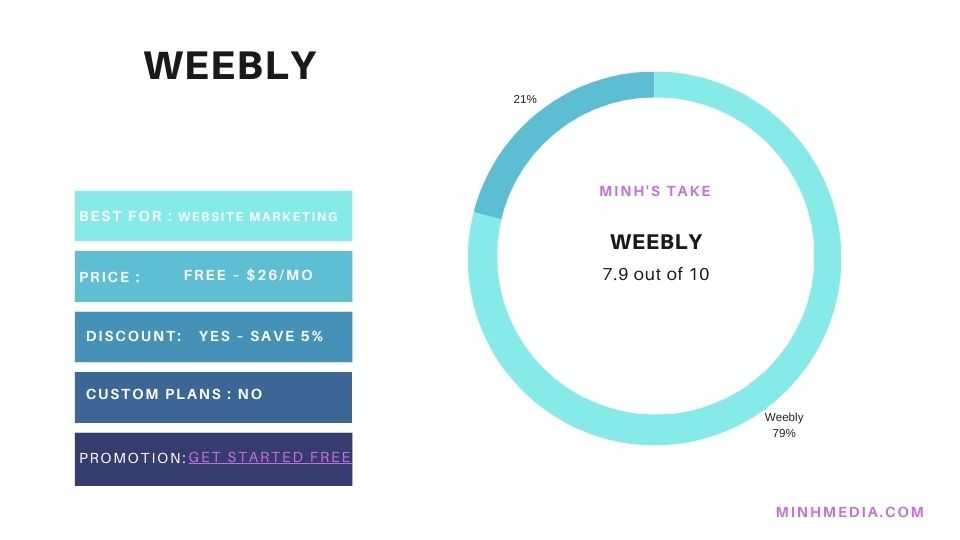
Weebly is a website building platform that enables users to create professional-looking websites without requiring extensive technical knowledge or coding skills. Here is a detailed introduction to the Weebly platform, including its history, technology, achievements, and features:
History: Weebly was founded in 2006 by David Rusenko, Chris Fanini, and Dan Veltri. The company started as a collaborative project while the founders were studying at Pennsylvania State University. They aimed to create a user-friendly platform that would make website creation accessible to everyone. Weebly quickly gained popularity and grew into a renowned website builder, attracting millions of users worldwide. In 2018, Weebly was acquired by Square, a prominent financial services and mobile payment company.
Technology: Weebly employs advanced web technologies to provide users with a seamless website building experience. The platform utilizes a drag-and-drop interface, allowing users to effortlessly add and arrange elements on their websites. Weebly’s backend infrastructure leverages cloud-based hosting, ensuring fast loading times and scalability. It also incorporates responsive design principles, enabling websites built on the platform to adapt to different screen sizes and devices.
Achievements: Over the years, Weebly has achieved significant milestones in the website building industry. Some of its notable achievements include:
- Large User Base: Weebly has amassed a large user base worldwide, with millions of individuals, entrepreneurs, and businesses relying on the platform to create their online presence.
- Industry Recognition: Weebly has received recognition and accolades for its user-friendly interface, design capabilities, and innovative features. It has been featured in various publications and received positive reviews for its website building tools.
- Acquisition by Square: In 2018, Weebly’s success and potential were recognized by Square, leading to its acquisition. This acquisition has allowed Weebly to further expand its offerings and leverage Square’s expertise in financial services and e-commerce.

Features: Weebly offers a range of features that empower users to build professional websites with ease. Some notable features include:
- Drag-and-Drop Editor: Weebly’s drag-and-drop editor enables users to build websites by simply dragging and dropping elements onto the page. This intuitive interface eliminates the need for coding knowledge and streamlines the website creation process.
- Templates and Customization: Weebly provides a collection of professionally designed templates that cater to various industries and purposes. Users can customize these templates to match their branding and preferences, adjusting colors, fonts, layouts, and more.
- E-commerce Functionality: Weebly offers robust e-commerce capabilities, allowing users to create online stores and sell products or services. The platform supports inventory management, secure transactions, integrated payment gateways, and order tracking.
- Mobile Responsiveness: Weebly ensures that websites built on its platform are mobile-responsive, providing a seamless browsing experience across devices. Websites automatically adjust their layout and content to suit different screen sizes, enhancing user experience on smartphones and tablets.
- App Center: Weebly’s App Center offers a variety of third-party integrations and add-ons to extend the platform’s functionality. Users can integrate tools for marketing, analytics, social media, and more to enhance their websites’ features and capabilities.
- SEO Tools: Weebly incorporates built-in search engine optimization (SEO) features to help users improve their website’s visibility in search engine rankings. Users can optimize page titles, meta descriptions, URLs, and alt tags to enhance their website’s search engine performance.
Weebly continues to evolve its platform, introducing new features and improvements to meet the ever-changing needs of website creators. Its user-friendly interface, customization options, e-commerce functionality, and focus on mobile responsiveness have made it a popular choice for individuals and businesses seeking an accessible and feature-rich
Like and Dislike of the Weebly Platform:

Like:
- User-Friendly Interface: Weebly is known for its user-friendly interface and intuitive drag-and-drop editor, making it easy for users to build websites without technical expertise.
- Customization Options: Weebly offers a wide range of customizable templates and design elements, allowing users to create unique and visually appealing websites.
- E-commerce Capabilities: Weebly provides robust e-commerce functionality, enabling users to create online stores with features like inventory management, secure transactions, and integrated payment gateways.
- Mobile Responsiveness: Websites built on Weebly are automatically optimized for mobile devices, ensuring a seamless browsing experience for visitors on smartphones and tablets.
- App Center: Weebly’s App Center offers a variety of integrations and add-ons, allowing users to extend their website’s functionality and integrate third-party tools.
Dislike:
- Design Limitations: While Weebly offers customization options, some users may find the design flexibility to be somewhat limited compared to other platforms, especially for advanced design customization.
- Template Switching: Switching templates on Weebly can be a bit challenging, as it requires manually transferring content and settings from one template to another.
- Limited Blogging Features: Weebly’s blogging capabilities are not as robust as dedicated blogging platforms, lacking some advanced features that bloggers may require.
- SEO Limitations: Although Weebly provides basic SEO tools, some users may find them to be limited in terms of advanced SEO customization and optimization options.
It’s important to note that these likes and dislikes are subjective and may vary based on individual preferences and specific website requirements. It’s recommended to explore the platform and consider personal needs before making a decision.
Weebly offers several pricing plans :
Please note that pricing may have changed, and it’s recommended to visit the Weebly website for the most up-to-date information.

- Free Plan: Weebly provides a free plan that allows users to create a basic website with limited features. This plan includes a Weebly subdomain (e.g., yoursite.weebly.com) and provides essential tools for website building. However, it may display Weebly ads on your site.
- Personal Plan: The Personal plan is designed for individuals and costs around $10 per month (billed annually). It includes a free domain for one year, removes Weebly ads, and offers additional features such as site search, basic e-commerce functionality (up to 10 products), and the ability to connect a custom domain.
- Professional Plan: The Professional plan is suitable for entrepreneurs and small businesses. It is priced at approximately $12 per month (billed annually). This plan includes all the features of the Personal plan, along with unlimited storage, advanced site statistics, password protection for pages, and expanded e-commerce capabilities (up to 25 products).
- Performance Plan: The Performance plan is geared towards businesses that require advanced features and scalability. It costs around $26 per month (billed annually). In addition to the features of the Professional plan, this plan offers integrated e-commerce features, including real-time shipping rates, abandoned cart recovery, gift cards, and more.
Weebly also offers additional services, such as email marketing and online advertising, which may have separate costs depending on the specific requirements.
It’s important to note that prices may vary based on factors like your location and the currency you use. Weebly occasionally offers promotions and discounts, so it’s advisable to check the Weebly website for any ongoing offers or changes in pricing.
Some common areas of updates on website building platforms like Weebly may include:
- New Templates: Weebly may introduce new professionally designed templates to offer users a wider range of options for their website designs. These templates may cater to different industries or specific website purposes.
- Feature Enhancements: Weebly may enhance existing features based on user feedback and industry trends. This can involve improving the drag-and-drop editor, adding new customization options, or refining the e-commerce functionality.
- Mobile Optimization: With the increasing use of mobile devices, Weebly may focus on optimizing websites for mobile responsiveness and improving the mobile editing experience.
- E-commerce Updates: Weebly may introduce new e-commerce features and integrations to help users manage their online stores more effectively. This can include improvements to inventory management, order processing, payment options, and marketing tools.
- Performance and Security: Weebly may release updates to improve website performance, loading times, and security measures. This ensures that websites built on the platform are fast, reliable, and protected against potential threats.
Experience User?
Weebly is widely regarded for its user-friendly interface and intuitive website building experience. Users appreciate the platform for its simplicity and ease of use, especially for individuals and small businesses who may not have extensive technical skills or coding knowledge. Here are some aspects of the user experience on Weebly:
- Drag-and-Drop Interface: Weebly’s drag-and-drop editor allows users to build their websites by simply dragging and dropping elements onto the page. This visual approach eliminates the need for manual coding and makes it easy to create and arrange content elements.
- User-Friendly Design: Weebly provides a clean and organized design interface, with intuitive menus and options. Users can easily navigate through the various settings, customization options, and page layouts, making the website creation process straightforward.
- Customization Options: Weebly offers a range of customizable templates and design elements, allowing users to create unique and personalized websites. Users can customize colors, fonts, layouts, and add their own images and branding to match their business or personal style.
- Pre-built Sections and Blocks: Weebly provides pre-built sections and blocks that users can insert into their website, making it quicker to create specific page layouts. These sections can include features like contact forms, galleries, testimonials, and more, saving users time and effort in designing from scratch.
- Responsive Design: Weebly ensures that websites built on its platform are mobile-responsive, meaning they automatically adapt and display properly on different devices and screen sizes. This enhances the user experience for visitors accessing the website from smartphones or tablets.
- E-commerce Functionality: Weebly’s e-commerce capabilities are highly appreciated by users who want to sell products or services online. The platform offers tools for managing inventory, processing payments, setting up shipping options, and tracking orders, simplifying the process of running an online store.
- Support and Resources: Weebly provides user support through various channels, including a help center, knowledge base, and community forum. Users can find tutorials, guides, and troubleshooting resources to assist them in using the platform effectively.
It’s important to note that user experience can vary based on individual needs, technical proficiency, and specific requirements. However, Weebly’s emphasis on simplicity, customization options, and user-friendly design has generally resulted in positive user experiences, especially for those seeking a user-friendly website building solution.
#7 Shopify: Build your business with Shopify to sell online, offline, and everywhere in between.

Shopify is a popular e-commerce platform that provides businesses with the tools and features necessary to create and manage their online stores. Let’s dive into a detailed introduction to Shopify, covering its history, technology, achievements, and features.
History: Shopify was founded in 2006 by Tobias Lütke, Daniel Weinand, and Scott Lake. The platform was initially developed to sell snowboards online, but its success led to its expansion as a comprehensive e-commerce solution. Over the years, Shopify has grown exponentially and is now used by millions of businesses worldwide.
Technology: Shopify is built on a robust and scalable technology infrastructure that ensures reliability and performance for online stores. It utilizes a combination of programming languages, including Ruby on Rails for the back-end and JavaScript for the front-end. Shopify leverages cloud-based hosting and content delivery networks (CDNs) to ensure fast loading times and handle high levels of traffic.
Achievements:
- Growth and Market Share: Shopify has experienced significant growth since its inception. It has become one of the leading e-commerce platforms globally, with a substantial market share and a strong presence in the industry.
- Public Listing: In 2015, Shopify went public and started trading on the New York Stock Exchange (NYSE) and the Toronto Stock Exchange (TSX). Its successful initial public offering (IPO) further solidified its position in the e-commerce market.
- Partner Ecosystem: Shopify has cultivated a thriving partner ecosystem comprising developers, designers, and agencies that contribute to the platform’s growth. This ecosystem offers a wide range of apps, themes, and services that enhance the functionality and customization options for Shopify users.

Features:
- Store Customization: Shopify provides a range of customizable themes and templates, allowing businesses to create visually appealing and unique online stores. Users can customize the design, layout, and branding to align with their brand identity.
- Product Management: Shopify offers powerful tools for managing products, inventory, and variants. Users can easily add, edit, and organize their products, set pricing and stock levels, and manage SKUs and product attributes.
- Payment and Checkout: The platform supports a variety of payment gateways, including Shopify Payments, which allows businesses to accept credit card payments directly. It also offers a seamless checkout experience with features like abandoned cart recovery and one-click upsells.
- Marketing and SEO: Shopify includes built-in marketing and SEO features to help businesses promote their stores. It offers options for discount codes, gift cards, email marketing, and social media integrations. Additionally, Shopify provides essential SEO tools and features to optimize product pages and improve search engine rankings.
- Order Management: Shopify streamlines the order fulfillment process with features such as order tracking, shipping label generation, and inventory management. It integrates with various shipping carriers and supports dropshipping and fulfillment by Amazon (FBA).
- App Store: Shopify’s App Store offers a vast selection of apps and extensions to extend the platform’s functionality. Users can find apps for additional marketing tools, analytics, customer support, and integration with third-party services.
Shopify continues to innovate and introduce new features and updates to enhance its platform and cater to the evolving needs of businesses in the e-commerce industry.
Like and Dislike of Shopify Platform:

Like:
- User-Friendly Interface: Shopify is known for its intuitive and user-friendly interface, making it accessible to users with varying levels of technical expertise. The platform’s drag-and-drop functionality and easy-to-navigate dashboard simplify the process of setting up and managing an online store.
- Extensive App Store: Shopify’s App Store offers a wide range of third-party apps and integrations that enhance the platform’s functionality. Users can find apps for marketing, inventory management, customer support, analytics, and more, allowing them to customize their online stores according to their specific needs.
- Mobile Responsiveness: Shopify provides mobile-responsive themes and ensures that online stores built on the platform are optimized for mobile devices. This allows businesses to cater to the growing number of customers who shop using smartphones and tablets.
- Secure and Reliable: Shopify takes security and reliability seriously. The platform handles all aspects of security, including hosting, data protection, and compliance with industry standards. Users can have peace of mind knowing that their customers’ data is protected and their online stores are reliable.
- Scalability and Performance: Shopify’s infrastructure is designed to handle high volumes of traffic and transactions, making it suitable for businesses of all sizes. The platform’s scalable architecture ensures that online stores can grow as the business expands, without compromising performance.
Dislike:
- Cost: Some users may find Shopify’s pricing plans relatively higher compared to other e-commerce platforms. While Shopify offers a range of plans to accommodate different budgets, businesses with limited financial resources may find the costs challenging, especially when factoring in transaction fees and additional app expenses.
- Customization Limitations: Although Shopify provides a variety of customizable themes and templates, some users may find the level of customization options limited compared to self-hosted solutions. Users with specific design requirements or those seeking complete design freedom may find the customization options somewhat restrictive.
- Learning Curve: While Shopify is generally user-friendly, users who are new to e-commerce or website development may experience a learning curve when setting up and managing their online stores. Some advanced features may require technical knowledge or the assistance of developers.
It’s important to note that the likes and dislikes can vary depending on individual needs, preferences, and business requirements. Shopify has been widely adopted and praised by many businesses for its comprehensive features, reliability, and support, but it’s advisable to evaluate the platform’s suitability based on specific needs and consider personal preferences before making a decision.
Shopify offers a range of pricing plans:


- Basic Shopify: This plan starts at $39 per month and includes essential features for starting a new online store. It allows businesses to sell an unlimited number of products, provides 24/7 customer support, and offers features like discount codes, abandoned cart recovery, and a free SSL certificate.
- Advanced Shopify: This plan starts at $399 per month and is designed for businesses with higher-volume sales. It includes advanced features such as advanced report building, third-party calculated shipping rates, and a dedicated SSL certificate.
- In addition to the above pricing plans, Shopify also offers an enterprise-level plan called Shopify Plus: $2000, which is tailored to large-scale businesses with complex needs. The pricing for Shopify Plus is determined on a case-by-case basis and can vary depending on the specific requirements of the business.
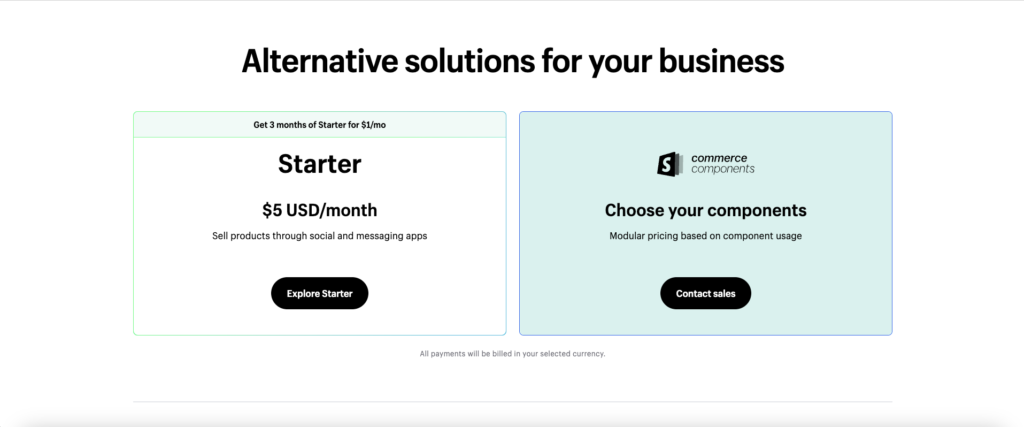
It’s important to note that the pricing mentioned here is subject to change, and Shopify may introduce new plans or adjust their pricing structure. It’s recommended to visit the official Shopify website or contact their sales team to get the most up-to-date and accurate information regarding pricing and any promotional offers that may be available.
Updates Platform ?

Shopify is known for regularly updating its platform to enhance user experience, introduce new features, and address customer needs. Some typical areas of improvement and updates include:
- Feature Enhancements: Shopify continuously works on improving existing features and introducing new ones. These updates may include enhancements to the website builder, checkout process, inventory management, reporting capabilities, and integrations with third-party apps.
- Mobile Optimization: As mobile commerce continues to grow, Shopify focuses on optimizing the platform for mobile devices. This includes responsive design, mobile-friendly themes, and mobile app enhancements to ensure a seamless shopping experience for customers using smartphones and tablets.
- Security and Compliance: Shopify places a strong emphasis on security and compliance with industry standards. The platform regularly updates its security measures to protect user data, transactions, and sensitive information. This includes staying up-to-date with the latest security protocols and maintaining compliance with regulations like the Payment Card Industry Data Security Standard (PCI DSS).
- Performance and Scalability: Shopify aims to provide a robust and scalable platform for businesses of all sizes. Updates may involve infrastructure improvements, server optimizations, and performance enhancements to ensure fast loading times, high uptime, and the ability to handle increased traffic and sales volumes.
- App and Theme Marketplace: Shopify’s App Store and Theme Store are continually updated with new apps, plugins, and themes developed by third-party developers. These updates expand the range of options available to merchants, allowing them to customize and extend the functionality of their online stores.
- User Interface and User Experience: Shopify pays attention to user feedback and continually refines the platform’s user interface (UI) and user experience (UX). This includes streamlining workflows, simplifying navigation, and improving the overall usability of the platform.
To stay informed about the latest updates and changes, I recommend subscribing to Shopify’s official blog, following their social media channels, or checking their documentation for announcements and release notes.
Experience User?
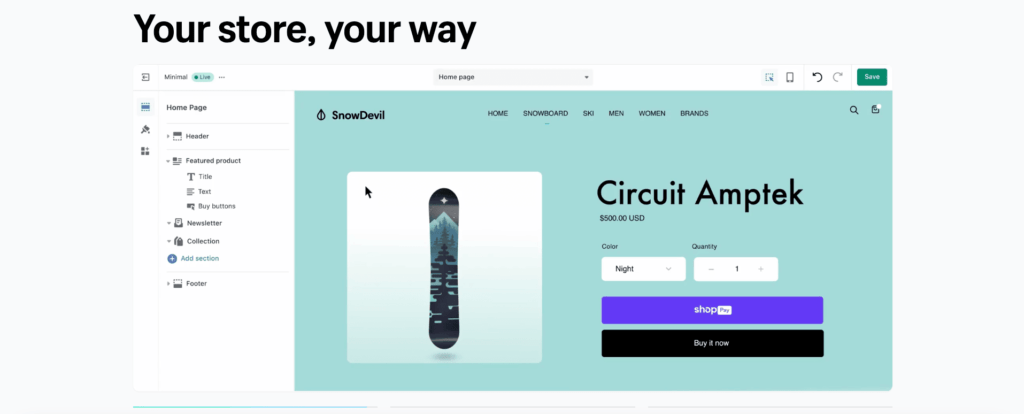
Shopify provides a positive user experience for both merchants and customers. Here are some key aspects of the user experience on the Shopify platform:
- Easy Store Setup: Shopify offers a user-friendly interface that makes it easy for merchants to set up their online stores without requiring extensive technical knowledge. The platform provides a step-by-step guided process, intuitive design tools, and pre-designed templates that allow users to quickly customize the look and feel of their stores.
- Intuitive Dashboard: The Shopify dashboard provides a central hub where merchants can manage their store’s inventory, orders, customers, and marketing campaigns. The dashboard is designed with simplicity in mind, making it easy for users to navigate and access the various features and settings.
- Responsive Design: Shopify ensures that online stores built on the platform are mobile-responsive, meaning they adapt to different screen sizes and devices. This provides a seamless shopping experience for customers who access the stores on smartphones, tablets, or desktop computers.
- App Ecosystem: Shopify has a robust app ecosystem with a wide range of third-party apps and integrations available in the Shopify App Store. Merchants can choose from various apps to extend the functionality of their stores, such as marketing tools, inventory management systems, customer support solutions, and more. This allows users to customize and enhance their stores according to their specific business needs.
- Payment and Checkout Options: Shopify offers a streamlined checkout process, allowing customers to complete their purchases quickly and easily. The platform supports multiple payment gateways, including its own payment solution called Shopify Payments, as well as integration with popular payment providers. This gives customers flexibility in choosing their preferred payment method.
- Support and Resources: Shopify provides comprehensive support and resources to help merchants succeed. This includes 24/7 customer support through various channels, including live chat, email, and phone. Additionally, Shopify offers extensive documentation, tutorials, forums, and educational resources to assist users in setting up and managing their stores effectively.
- Scalability and Reliability: Shopify’s infrastructure is designed to handle the scalability and reliability requirements of growing businesses. The platform can accommodate high levels of traffic and transaction volumes without compromising performance. Shopify also ensures the security and uptime of online stores through robust hosting and backup systems.
The user experience on Shopify is highly regarded for its user-friendly interface, customizable design options, extensive app ecosystem, and strong support resources. These factors contribute to a positive and smooth experience for both merchants and customers using the platform.
#8 HubSpot Content Management System, Best Website Tool with Integrated CRM Tools ($45- $3200/month)

HubSpot is a leading customer relationship management (CRM) and inbound marketing software platform. It provides a suite of tools and features to help businesses attract, engage, and delight customers. Here is a detailed introduction to the HubSpot platform, covering its history, technology, achievements, and features:
History: HubSpot was founded in 2006 by Brian Halligan and Dharmesh Shah, with the aim of transforming how businesses market and sell their products and services. The company introduced the concept of inbound marketing, which focuses on attracting customers through valuable content and personalized experiences. Over the years, HubSpot has grown into a global software company with thousands of customers worldwide.
Technology: HubSpot’s platform is built on a cloud-based infrastructure, leveraging cutting-edge technology to deliver its CRM and marketing automation capabilities. The platform combines multiple tools into a single, integrated system, providing a seamless experience for users. HubSpot utilizes artificial intelligence (AI) and machine learning algorithms to enable automation, personalization, and data-driven insights.
Achievements: HubSpot has received numerous accolades for its innovative platform and contributions to the marketing and sales industry. Some notable achievements include:

- Recognition as a leader in the Gartner Magic Quadrant for CRM Lead Management and CRM Customer Engagement Center.
- Inclusion in Forbes Cloud 100 list of top private cloud companies.
- HubSpot’s co-founders, Brian Halligan and Dharmesh Shah, being recognized as influential figures in the technology and marketing fields.
Features:

- CRM: HubSpot offers a comprehensive CRM platform that allows businesses to manage their customer interactions, sales pipeline, and marketing efforts in one place. The CRM provides a centralized database, contact management, deal tracking, and analytics.
- Marketing Automation: HubSpot’s marketing automation tools enable businesses to automate their marketing campaigns, nurture leads, and deliver personalized content. Users can create and manage email marketing, social media campaigns, landing pages, forms, and more.
- Content Management System (CMS): The HubSpot CMS provides a powerful and user-friendly platform for creating and managing websites, blog posts, and landing pages. It includes drag-and-drop editors, customizable templates, SEO optimization features, and performance analytics.
- Sales and Service Hub: HubSpot offers Sales Hub and Service Hub, which provide tools for managing sales activities and customer service interactions. These hubs include features such as email tracking, lead scoring, customer support ticketing, knowledge base management, and live chat.
- Reporting and Analytics: HubSpot provides in-depth reporting and analytics capabilities to help businesses track their marketing and sales performance. Users can access real-time data, generate customizable reports, and gain insights into key metrics, campaign effectiveness, and customer behavior.
- Integration and Ecosystem: HubSpot integrates with a wide range of third-party applications and services, allowing businesses to extend the functionality of the platform. The HubSpot App Marketplace offers various integrations for CRM, marketing, sales, customer service, analytics, and more.
HubSpot’s platform has empowered businesses of all sizes to adopt inbound marketing strategies, automate their sales and marketing processes, and provide exceptional customer experiences. With its robust technology, comprehensive features, and commitment to innovation, HubSpot continues to be a leading player in the CRM and marketing automation space.
Like and dislike HubSpot Platform ?

Like:
- Comprehensive Suite: HubSpot offers a comprehensive suite of tools for CRM, marketing automation, sales, and customer service. Having all these functionalities integrated into one platform makes it convenient for businesses to manage their customer interactions and marketing efforts in a centralized manner.
- User-Friendly Interface: HubSpot is known for its user-friendly interface, making it accessible for users with varying technical backgrounds. The platform provides intuitive navigation, drag-and-drop editors, and customizable templates, allowing users to easily create and manage content without extensive coding knowledge.
- Automation and Personalization: HubSpot’s automation capabilities enable businesses to automate repetitive tasks, nurture leads, and deliver personalized content to their audience. The platform uses AI and machine learning to analyze customer data and provide actionable insights for more targeted and effective marketing campaigns.
- Extensive Reporting and Analytics: HubSpot offers robust reporting and analytics features, providing businesses with valuable insights into their marketing and sales performance. Users can track key metrics, monitor campaign effectiveness, and make data-driven decisions to optimize their strategies.
- Integration Ecosystem: HubSpot integrates with a wide range of third-party applications and services through its App Marketplace. This allows businesses to extend the functionality of the platform and integrate it with their existing tools, enhancing efficiency and productivity.
Dislike:
- Learning Curve: While HubSpot aims to provide a user-friendly interface, some users may find it initially challenging to navigate and understand the various features and functionalities. However, HubSpot offers extensive documentation, training resources, and customer support to help users overcome this learning curve.
- Pricing: HubSpot’s pricing can be perceived as relatively higher compared to some other CRM and marketing automation platforms. The cost may be a drawback for small businesses or startups with limited budgets. However, it’s important to consider the value and comprehensive features HubSpot offers when evaluating the pricing.
- Limited Customization Options: Although HubSpot provides customizable templates and design options, some users may feel limited in terms of complete customization. Advanced customization may require technical expertise or the assistance of a developer.
- Complexity for Complex Businesses: While HubSpot serves businesses of all sizes, some larger or more complex organizations with intricate sales processes or specific industry requirements may find certain limitations within the platform. However, HubSpot does offer enterprise-level solutions, such as HubSpot Enterprise, to cater to the needs of larger organizations.
It’s important to note that individual experiences with the HubSpot platform may vary based on specific business requirements, technical proficiency, and personal preferences. It’s recommended to explore a free trial or consult with the HubSpot sales team to evaluate if the platform aligns with your business needs and goals.
Prices Services:
HubSpot offers a range of pricing options to cater to different business needs. Here is an overview of their pricing structure as of the current information:
- CRM: HubSpot’s CRM is available for free, allowing businesses to manage their customer relationships, track interactions, and store contact information without any cost.
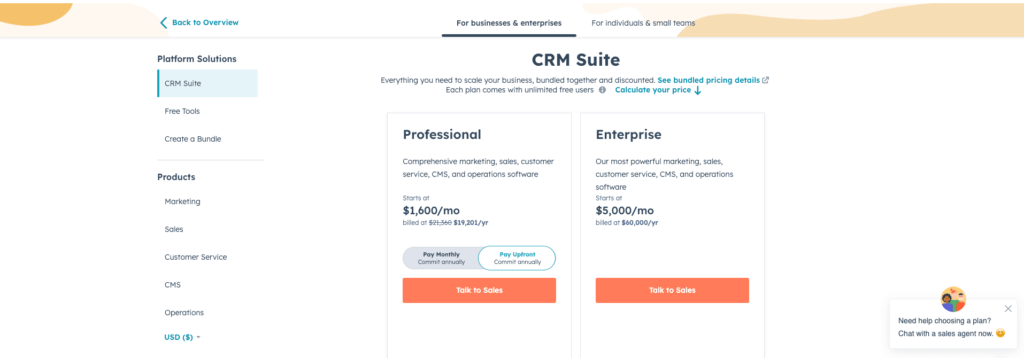
2. Marketing Hub: The Marketing Hub includes tools for marketing automation, email marketing, lead nurturing, analytics, and more. The pricing for the Marketing Hub starts at $50 per month and goes up to $3,200 per month, depending on the features and the size of your contact database.
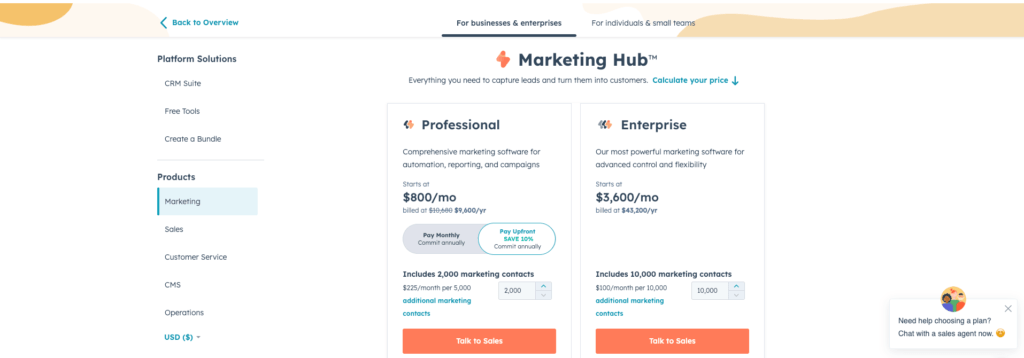
3. Sales Hub: The Sales Hub provides features for managing sales activities, tracking deals, email tracking, and sales analytics. The pricing for the Sales Hub starts at $50 per month and goes up to $1,200 per month, depending on the features and the number of users.
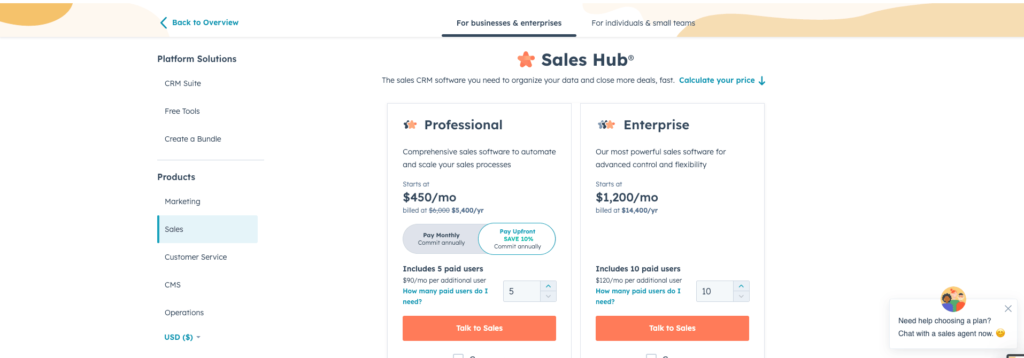
4. Service Hub: The Service Hub offers tools for customer support ticketing, knowledge base management, live chat, and customer feedback. The pricing for the Service Hub starts at $50 per month and goes up to $1,200 per month, depending on the features and the number of users.
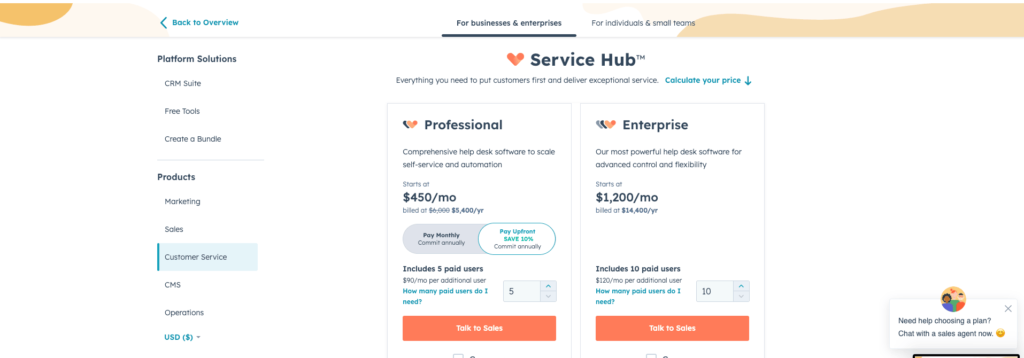
5. CMS Hub: The CMS Hub includes features for building and managing websites, blogs, and landing pages. The pricing for the CMS Hub starts at $300 per month and goes up to $900 per month, depending on the features and the number of users.
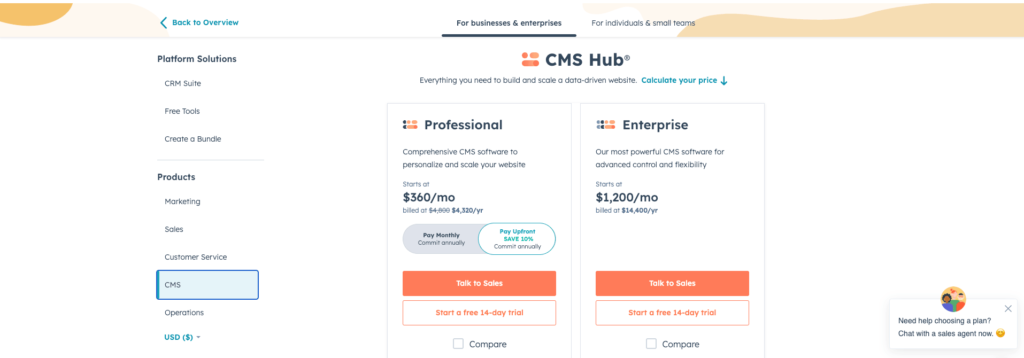
HubSpot also offers an Enterprise plan for businesses with more complex requirements. The pricing for the Enterprise plan is available upon request and can vary based on specific needs and customization.

Updates Platform ?
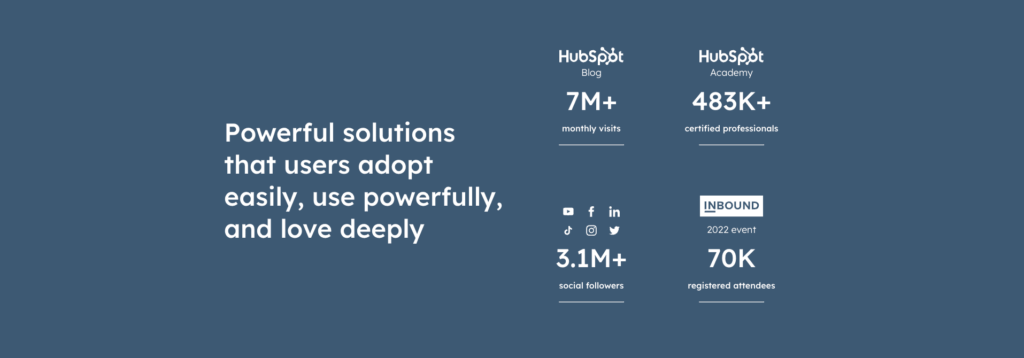
HubSpot regularly updates its platform to introduce new features, enhance existing functionalities, and improve the overall user experience. Here are some notable updates and developments from HubSpot:
- HubSpot CMS Hub: In recent updates, HubSpot has expanded its CMS Hub capabilities, offering more advanced features for website development and management. This includes additional customization options, drag-and-drop editing, and improved SEO optimization tools.
- Conversations: HubSpot has introduced a Conversations feature that enables businesses to have real-time conversations with their website visitors through live chat and chatbot capabilities. This helps businesses engage with prospects and customers directly, providing personalized support and assistance.
- Account-Based Marketing (ABM): HubSpot has enhanced its ABM tools, allowing businesses to create and manage account-based marketing campaigns more effectively. This includes features such as account segmentation, targeted advertising, and personalized content for specific accounts or industries.
- Sales Automation: HubSpot continues to enhance its Sales Hub with new automation capabilities. These updates include features like email sequences, task automation, and artificial intelligence-powered sales tools to streamline sales processes and improve efficiency.
- Reporting and Analytics: HubSpot regularly introduces updates to its reporting and analytics features, providing users with more advanced insights into their marketing and sales performance. These updates include improved dashboards, customizable reports, and data visualization tools to track key metrics and make data-driven decisions.
- Integration Marketplace: HubSpot has expanded its Integration Marketplace, offering a wider range of third-party integrations to enhance the functionality of the platform. This allows businesses to connect HubSpot with their preferred tools and services, streamlining workflows and improving productivity.
HubSpot’s platform updates are ongoing, with new features and improvements introduced on a regular basis. These updates aim to address user feedback, industry trends, and evolving customer needs. To stay updated on the latest platform updates, users can refer to the HubSpot product updates blog, subscribe to their newsletters, or attend webinars and events hosted by HubSpot.
Experience User ?
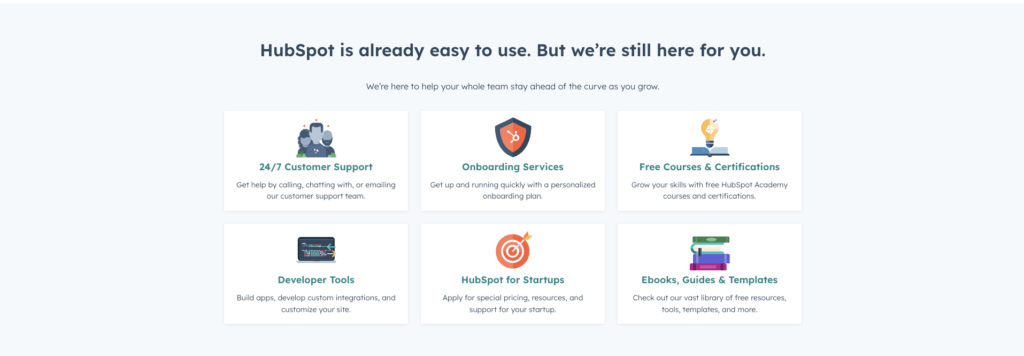
HubSpot provides a positive user experience for businesses across various industries. Here are some aspects of the user experience that HubSpot offers:
- User-Friendly Interface: HubSpot is known for its user-friendly interface, making it accessible to users with varying levels of technical expertise. The platform features a clean and intuitive design, with easy-to-navigate menus and tools. Users can quickly find the features they need and manage their marketing, sales, and customer service activities efficiently.
- Seamless Integration: HubSpot offers a seamless integration of its various tools and features within a unified platform. This integration allows users to access and manage their CRM, marketing automation, sales, and customer service activities in one place, eliminating the need for multiple software solutions. The integrated approach streamlines workflows and enhances collaboration among teams.
- Comprehensive Training and Support: HubSpot provides extensive training and support resources to help users make the most of the platform. The HubSpot Academy offers free certification courses and educational materials to help users learn best practices for inbound marketing, sales, and customer service. Additionally, HubSpot’s support team is available to assist users with any technical or platform-related queries.
- Customization and Personalization: HubSpot enables users to customize their experience according to their specific business needs. Users can tailor dashboards, reports, and workflows to match their preferences and requirements. The platform also allows for personalization of marketing campaigns, emails, and customer interactions, enabling businesses to create more targeted and engaging experiences.
- Data-Driven Insights: HubSpot provides robust reporting and analytics features, offering valuable insights into marketing, sales, and customer service performance. Users can track key metrics, monitor campaign effectiveness, and gain insights into customer behavior. These data-driven insights help businesses make informed decisions, optimize their strategies, and improve their overall performance.
- Community and Networking: HubSpot has a vibrant community of users, partners, and experts who actively share insights, tips, and best practices. Users can participate in forums, attend events, and join user groups to network with other professionals, exchange ideas, and stay updated on industry trends.
Overall, the user experience with HubSpot is highly regarded for its user-friendly interface, comprehensive training and support, customization options, data-driven insights, and community engagement. The platform aims to empower businesses to effectively manage their marketing, sales, and customer service efforts, driving growth and success.
continues…
DISCLAIMER : I am only sharing my biased opinion based of speculation, knowledge and my personal experience. You should always understand that with investing there is always risk. You should always do your own research before making any investment.
The content produced on MinhMedia.com and other materials is intended for informational reference, entertainment, and educational purposes only. The content is not designed to provide professional advice that you might get from a certified financial expert or legal expert, or anything else. Reliance on any information on our website or in our courses is done so at your own risk. The information is not intended to provide any certain type of financial or business outcome.

